Business Strategy and Management
VerifiedAdded on 2020/07/23
|18
|5320
|215
AI Summary
This assignment provides an in-depth analysis of business strategy and management, covering various tools and techniques used in the field. It includes references to key concepts such as Porter's Generic Competitive Strategies, the BCG Matrix, and stakeholders' analysis, among others. The assignment also touches on sustainable entrepreneurship, business model innovation, and the relationship between business strategy and performance.
Contribute Materials
Your contribution can guide someone’s learning journey. Share your
documents today.

Business Strategy
Secure Best Marks with AI Grader
Need help grading? Try our AI Grader for instant feedback on your assignments.
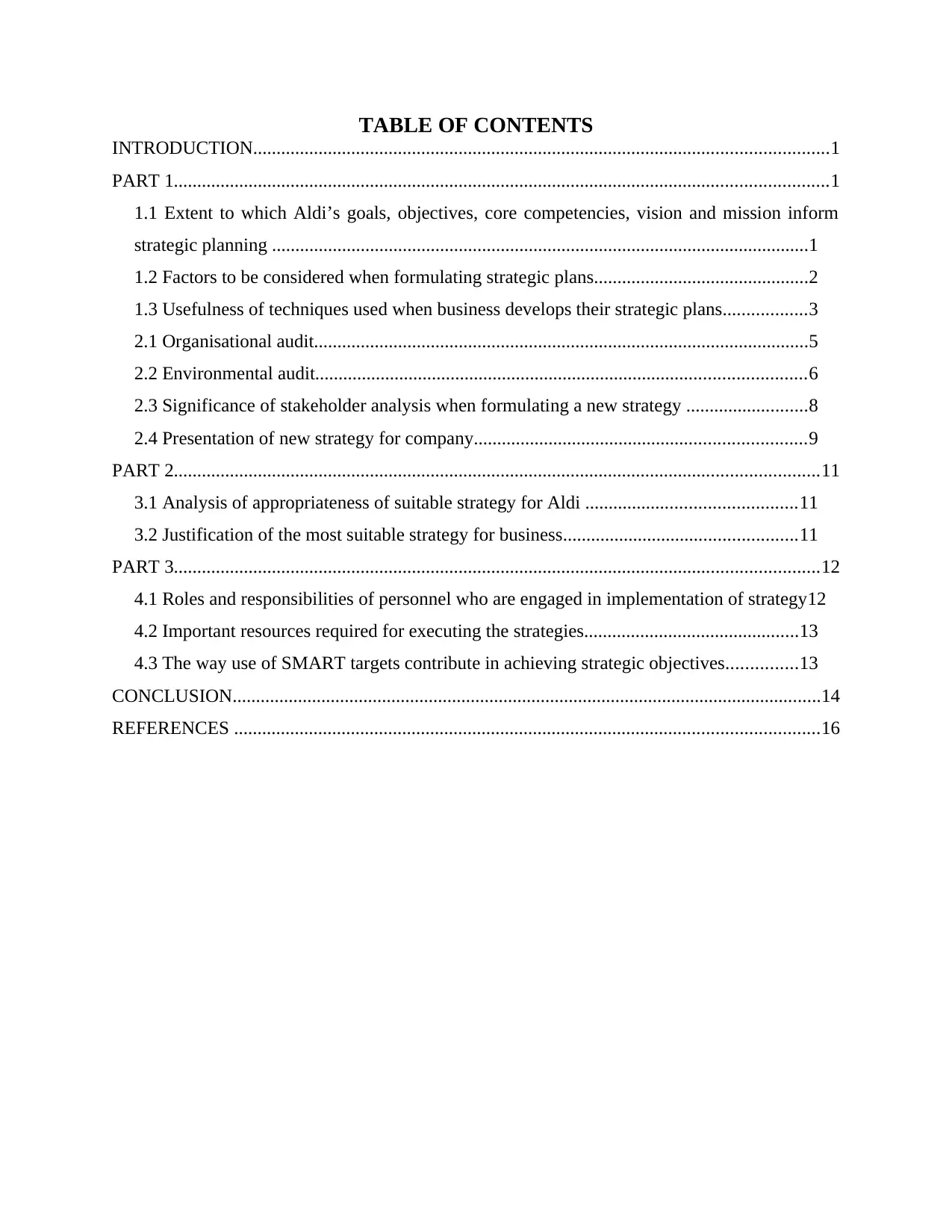
TABLE OF CONTENTS
INTRODUCTION...........................................................................................................................1
PART 1............................................................................................................................................1
1.1 Extent to which Aldi’s goals, objectives, core competencies, vision and mission inform
strategic planning ...................................................................................................................1
1.2 Factors to be considered when formulating strategic plans..............................................2
1.3 Usefulness of techniques used when business develops their strategic plans..................3
2.1 Organisational audit..........................................................................................................5
2.2 Environmental audit.........................................................................................................6
2.3 Significance of stakeholder analysis when formulating a new strategy ..........................8
2.4 Presentation of new strategy for company.......................................................................9
PART 2..........................................................................................................................................11
3.1 Analysis of appropriateness of suitable strategy for Aldi .............................................11
3.2 Justification of the most suitable strategy for business..................................................11
PART 3..........................................................................................................................................12
4.1 Roles and responsibilities of personnel who are engaged in implementation of strategy12
4.2 Important resources required for executing the strategies..............................................13
4.3 The way use of SMART targets contribute in achieving strategic objectives...............13
CONCLUSION..............................................................................................................................14
REFERENCES .............................................................................................................................16
INTRODUCTION...........................................................................................................................1
PART 1............................................................................................................................................1
1.1 Extent to which Aldi’s goals, objectives, core competencies, vision and mission inform
strategic planning ...................................................................................................................1
1.2 Factors to be considered when formulating strategic plans..............................................2
1.3 Usefulness of techniques used when business develops their strategic plans..................3
2.1 Organisational audit..........................................................................................................5
2.2 Environmental audit.........................................................................................................6
2.3 Significance of stakeholder analysis when formulating a new strategy ..........................8
2.4 Presentation of new strategy for company.......................................................................9
PART 2..........................................................................................................................................11
3.1 Analysis of appropriateness of suitable strategy for Aldi .............................................11
3.2 Justification of the most suitable strategy for business..................................................11
PART 3..........................................................................................................................................12
4.1 Roles and responsibilities of personnel who are engaged in implementation of strategy12
4.2 Important resources required for executing the strategies..............................................13
4.3 The way use of SMART targets contribute in achieving strategic objectives...............13
CONCLUSION..............................................................................................................................14
REFERENCES .............................................................................................................................16
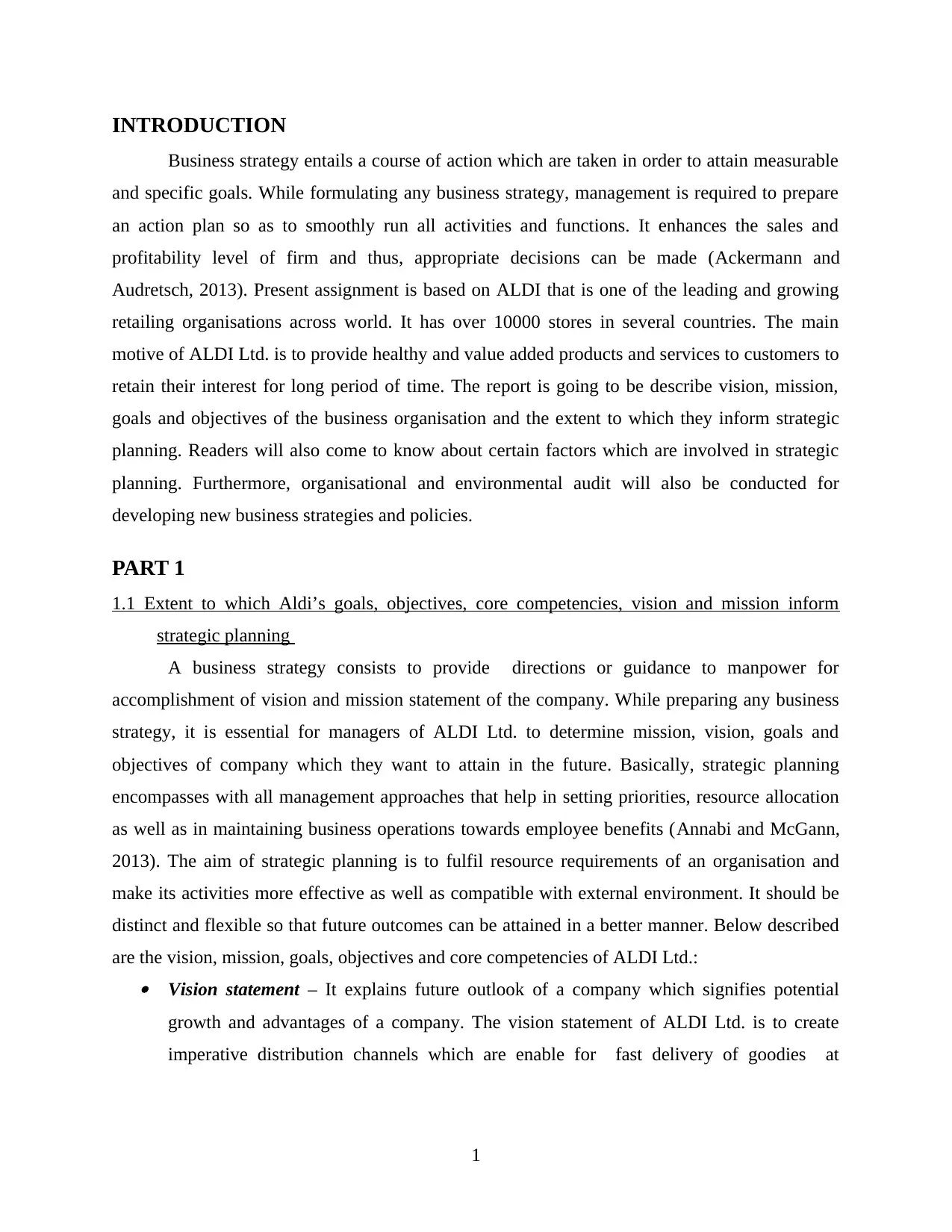
INTRODUCTION
Business strategy entails a course of action which are taken in order to attain measurable
and specific goals. While formulating any business strategy, management is required to prepare
an action plan so as to smoothly run all activities and functions. It enhances the sales and
profitability level of firm and thus, appropriate decisions can be made (Ackermann and
Audretsch, 2013). Present assignment is based on ALDI that is one of the leading and growing
retailing organisations across world. It has over 10000 stores in several countries. The main
motive of ALDI Ltd. is to provide healthy and value added products and services to customers to
retain their interest for long period of time. The report is going to be describe vision, mission,
goals and objectives of the business organisation and the extent to which they inform strategic
planning. Readers will also come to know about certain factors which are involved in strategic
planning. Furthermore, organisational and environmental audit will also be conducted for
developing new business strategies and policies.
PART 1
1.1 Extent to which Aldi’s goals, objectives, core competencies, vision and mission inform
strategic planning
A business strategy consists to provide directions or guidance to manpower for
accomplishment of vision and mission statement of the company. While preparing any business
strategy, it is essential for managers of ALDI Ltd. to determine mission, vision, goals and
objectives of company which they want to attain in the future. Basically, strategic planning
encompasses with all management approaches that help in setting priorities, resource allocation
as well as in maintaining business operations towards employee benefits (Annabi and McGann,
2013). The aim of strategic planning is to fulfil resource requirements of an organisation and
make its activities more effective as well as compatible with external environment. It should be
distinct and flexible so that future outcomes can be attained in a better manner. Below described
are the vision, mission, goals, objectives and core competencies of ALDI Ltd.: Vision statement – It explains future outlook of a company which signifies potential
growth and advantages of a company. The vision statement of ALDI Ltd. is to create
imperative distribution channels which are enable for fast delivery of goodies at
1
Business strategy entails a course of action which are taken in order to attain measurable
and specific goals. While formulating any business strategy, management is required to prepare
an action plan so as to smoothly run all activities and functions. It enhances the sales and
profitability level of firm and thus, appropriate decisions can be made (Ackermann and
Audretsch, 2013). Present assignment is based on ALDI that is one of the leading and growing
retailing organisations across world. It has over 10000 stores in several countries. The main
motive of ALDI Ltd. is to provide healthy and value added products and services to customers to
retain their interest for long period of time. The report is going to be describe vision, mission,
goals and objectives of the business organisation and the extent to which they inform strategic
planning. Readers will also come to know about certain factors which are involved in strategic
planning. Furthermore, organisational and environmental audit will also be conducted for
developing new business strategies and policies.
PART 1
1.1 Extent to which Aldi’s goals, objectives, core competencies, vision and mission inform
strategic planning
A business strategy consists to provide directions or guidance to manpower for
accomplishment of vision and mission statement of the company. While preparing any business
strategy, it is essential for managers of ALDI Ltd. to determine mission, vision, goals and
objectives of company which they want to attain in the future. Basically, strategic planning
encompasses with all management approaches that help in setting priorities, resource allocation
as well as in maintaining business operations towards employee benefits (Annabi and McGann,
2013). The aim of strategic planning is to fulfil resource requirements of an organisation and
make its activities more effective as well as compatible with external environment. It should be
distinct and flexible so that future outcomes can be attained in a better manner. Below described
are the vision, mission, goals, objectives and core competencies of ALDI Ltd.: Vision statement – It explains future outlook of a company which signifies potential
growth and advantages of a company. The vision statement of ALDI Ltd. is to create
imperative distribution channels which are enable for fast delivery of goodies at
1
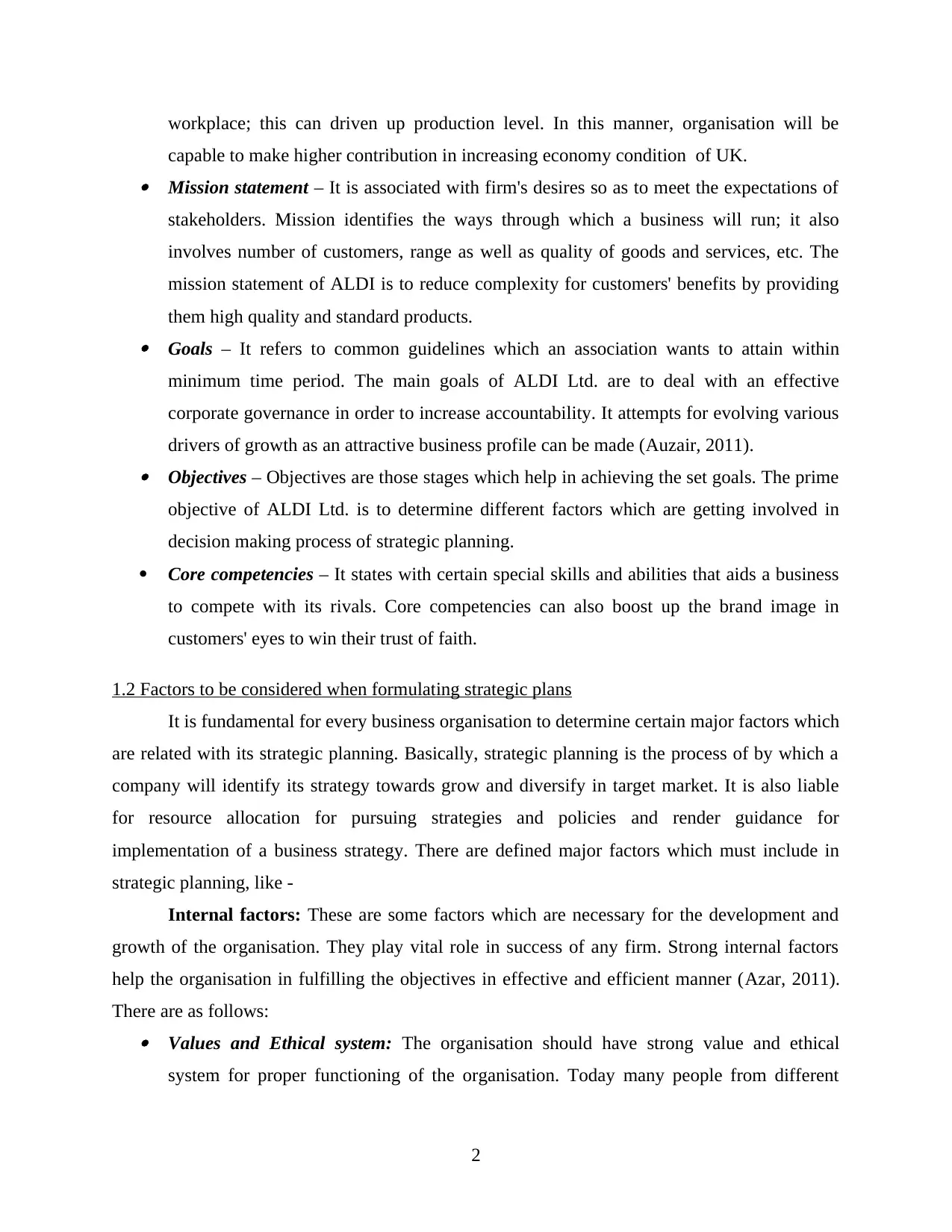
workplace; this can driven up production level. In this manner, organisation will be
capable to make higher contribution in increasing economy condition of UK. Mission statement – It is associated with firm's desires so as to meet the expectations of
stakeholders. Mission identifies the ways through which a business will run; it also
involves number of customers, range as well as quality of goods and services, etc. The
mission statement of ALDI is to reduce complexity for customers' benefits by providing
them high quality and standard products. Goals – It refers to common guidelines which an association wants to attain within
minimum time period. The main goals of ALDI Ltd. are to deal with an effective
corporate governance in order to increase accountability. It attempts for evolving various
drivers of growth as an attractive business profile can be made (Auzair, 2011). Objectives – Objectives are those stages which help in achieving the set goals. The prime
objective of ALDI Ltd. is to determine different factors which are getting involved in
decision making process of strategic planning.
Core competencies – It states with certain special skills and abilities that aids a business
to compete with its rivals. Core competencies can also boost up the brand image in
customers' eyes to win their trust of faith.
1.2 Factors to be considered when formulating strategic plans
It is fundamental for every business organisation to determine certain major factors which
are related with its strategic planning. Basically, strategic planning is the process of by which a
company will identify its strategy towards grow and diversify in target market. It is also liable
for resource allocation for pursuing strategies and policies and render guidance for
implementation of a business strategy. There are defined major factors which must include in
strategic planning, like -
Internal factors: These are some factors which are necessary for the development and
growth of the organisation. They play vital role in success of any firm. Strong internal factors
help the organisation in fulfilling the objectives in effective and efficient manner (Azar, 2011).
There are as follows: Values and Ethical system: The organisation should have strong value and ethical
system for proper functioning of the organisation. Today many people from different
2
capable to make higher contribution in increasing economy condition of UK. Mission statement – It is associated with firm's desires so as to meet the expectations of
stakeholders. Mission identifies the ways through which a business will run; it also
involves number of customers, range as well as quality of goods and services, etc. The
mission statement of ALDI is to reduce complexity for customers' benefits by providing
them high quality and standard products. Goals – It refers to common guidelines which an association wants to attain within
minimum time period. The main goals of ALDI Ltd. are to deal with an effective
corporate governance in order to increase accountability. It attempts for evolving various
drivers of growth as an attractive business profile can be made (Auzair, 2011). Objectives – Objectives are those stages which help in achieving the set goals. The prime
objective of ALDI Ltd. is to determine different factors which are getting involved in
decision making process of strategic planning.
Core competencies – It states with certain special skills and abilities that aids a business
to compete with its rivals. Core competencies can also boost up the brand image in
customers' eyes to win their trust of faith.
1.2 Factors to be considered when formulating strategic plans
It is fundamental for every business organisation to determine certain major factors which
are related with its strategic planning. Basically, strategic planning is the process of by which a
company will identify its strategy towards grow and diversify in target market. It is also liable
for resource allocation for pursuing strategies and policies and render guidance for
implementation of a business strategy. There are defined major factors which must include in
strategic planning, like -
Internal factors: These are some factors which are necessary for the development and
growth of the organisation. They play vital role in success of any firm. Strong internal factors
help the organisation in fulfilling the objectives in effective and efficient manner (Azar, 2011).
There are as follows: Values and Ethical system: The organisation should have strong value and ethical
system for proper functioning of the organisation. Today many people from different
2
Secure Best Marks with AI Grader
Need help grading? Try our AI Grader for instant feedback on your assignments.
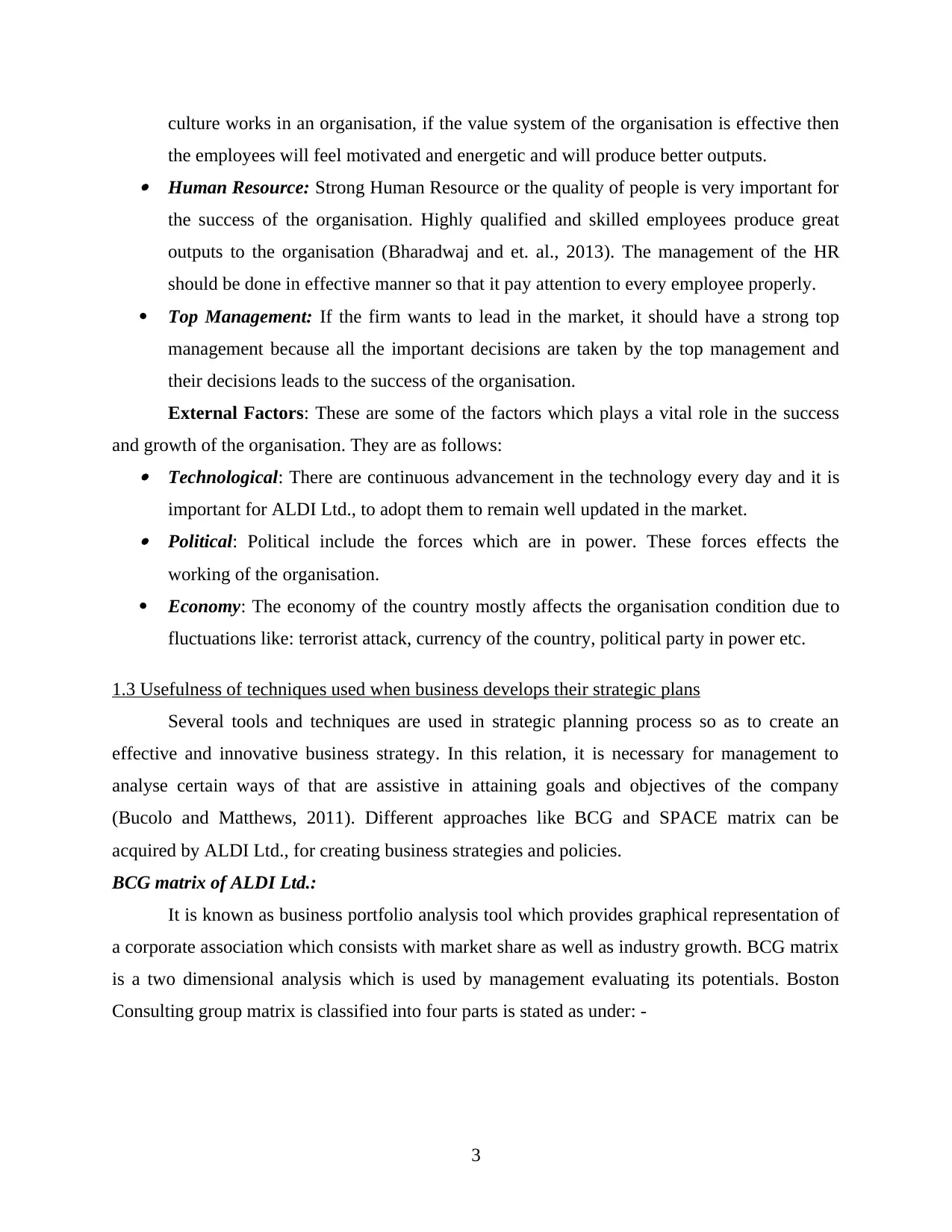
culture works in an organisation, if the value system of the organisation is effective then
the employees will feel motivated and energetic and will produce better outputs. Human Resource: Strong Human Resource or the quality of people is very important for
the success of the organisation. Highly qualified and skilled employees produce great
outputs to the organisation (Bharadwaj and et. al., 2013). The management of the HR
should be done in effective manner so that it pay attention to every employee properly.
Top Management: If the firm wants to lead in the market, it should have a strong top
management because all the important decisions are taken by the top management and
their decisions leads to the success of the organisation.
External Factors: These are some of the factors which plays a vital role in the success
and growth of the organisation. They are as follows: Technological: There are continuous advancement in the technology every day and it is
important for ALDI Ltd., to adopt them to remain well updated in the market. Political: Political include the forces which are in power. These forces effects the
working of the organisation.
Economy: The economy of the country mostly affects the organisation condition due to
fluctuations like: terrorist attack, currency of the country, political party in power etc.
1.3 Usefulness of techniques used when business develops their strategic plans
Several tools and techniques are used in strategic planning process so as to create an
effective and innovative business strategy. In this relation, it is necessary for management to
analyse certain ways of that are assistive in attaining goals and objectives of the company
(Bucolo and Matthews, 2011). Different approaches like BCG and SPACE matrix can be
acquired by ALDI Ltd., for creating business strategies and policies.
BCG matrix of ALDI Ltd.:
It is known as business portfolio analysis tool which provides graphical representation of
a corporate association which consists with market share as well as industry growth. BCG matrix
is a two dimensional analysis which is used by management evaluating its potentials. Boston
Consulting group matrix is classified into four parts is stated as under: -
3
the employees will feel motivated and energetic and will produce better outputs. Human Resource: Strong Human Resource or the quality of people is very important for
the success of the organisation. Highly qualified and skilled employees produce great
outputs to the organisation (Bharadwaj and et. al., 2013). The management of the HR
should be done in effective manner so that it pay attention to every employee properly.
Top Management: If the firm wants to lead in the market, it should have a strong top
management because all the important decisions are taken by the top management and
their decisions leads to the success of the organisation.
External Factors: These are some of the factors which plays a vital role in the success
and growth of the organisation. They are as follows: Technological: There are continuous advancement in the technology every day and it is
important for ALDI Ltd., to adopt them to remain well updated in the market. Political: Political include the forces which are in power. These forces effects the
working of the organisation.
Economy: The economy of the country mostly affects the organisation condition due to
fluctuations like: terrorist attack, currency of the country, political party in power etc.
1.3 Usefulness of techniques used when business develops their strategic plans
Several tools and techniques are used in strategic planning process so as to create an
effective and innovative business strategy. In this relation, it is necessary for management to
analyse certain ways of that are assistive in attaining goals and objectives of the company
(Bucolo and Matthews, 2011). Different approaches like BCG and SPACE matrix can be
acquired by ALDI Ltd., for creating business strategies and policies.
BCG matrix of ALDI Ltd.:
It is known as business portfolio analysis tool which provides graphical representation of
a corporate association which consists with market share as well as industry growth. BCG matrix
is a two dimensional analysis which is used by management evaluating its potentials. Boston
Consulting group matrix is classified into four parts is stated as under: -
3
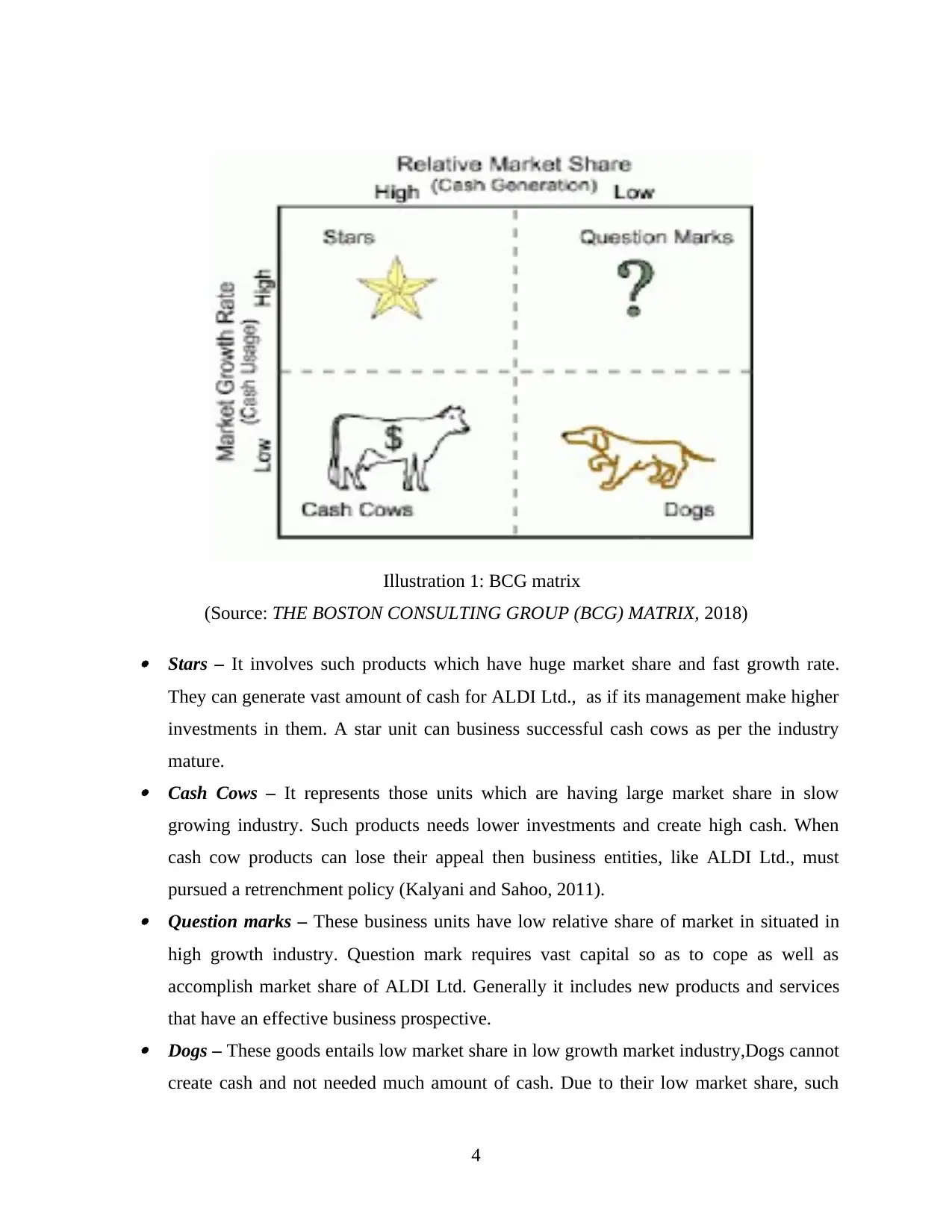
(Source: THE BOSTON CONSULTING GROUP (BCG) MATRIX, 2018)
Stars – It involves such products which have huge market share and fast growth rate.
They can generate vast amount of cash for ALDI Ltd., as if its management make higher
investments in them. A star unit can business successful cash cows as per the industry
mature. Cash Cows – It represents those units which are having large market share in slow
growing industry. Such products needs lower investments and create high cash. When
cash cow products can lose their appeal then business entities, like ALDI Ltd., must
pursued a retrenchment policy (Kalyani and Sahoo, 2011). Question marks – These business units have low relative share of market in situated in
high growth industry. Question mark requires vast capital so as to cope as well as
accomplish market share of ALDI Ltd. Generally it includes new products and services
that have an effective business prospective. Dogs – These goods entails low market share in low growth market industry,Dogs cannot
create cash and not needed much amount of cash. Due to their low market share, such
4
Illustration 1: BCG matrix
Stars – It involves such products which have huge market share and fast growth rate.
They can generate vast amount of cash for ALDI Ltd., as if its management make higher
investments in them. A star unit can business successful cash cows as per the industry
mature. Cash Cows – It represents those units which are having large market share in slow
growing industry. Such products needs lower investments and create high cash. When
cash cow products can lose their appeal then business entities, like ALDI Ltd., must
pursued a retrenchment policy (Kalyani and Sahoo, 2011). Question marks – These business units have low relative share of market in situated in
high growth industry. Question mark requires vast capital so as to cope as well as
accomplish market share of ALDI Ltd. Generally it includes new products and services
that have an effective business prospective. Dogs – These goods entails low market share in low growth market industry,Dogs cannot
create cash and not needed much amount of cash. Due to their low market share, such
4
Illustration 1: BCG matrix
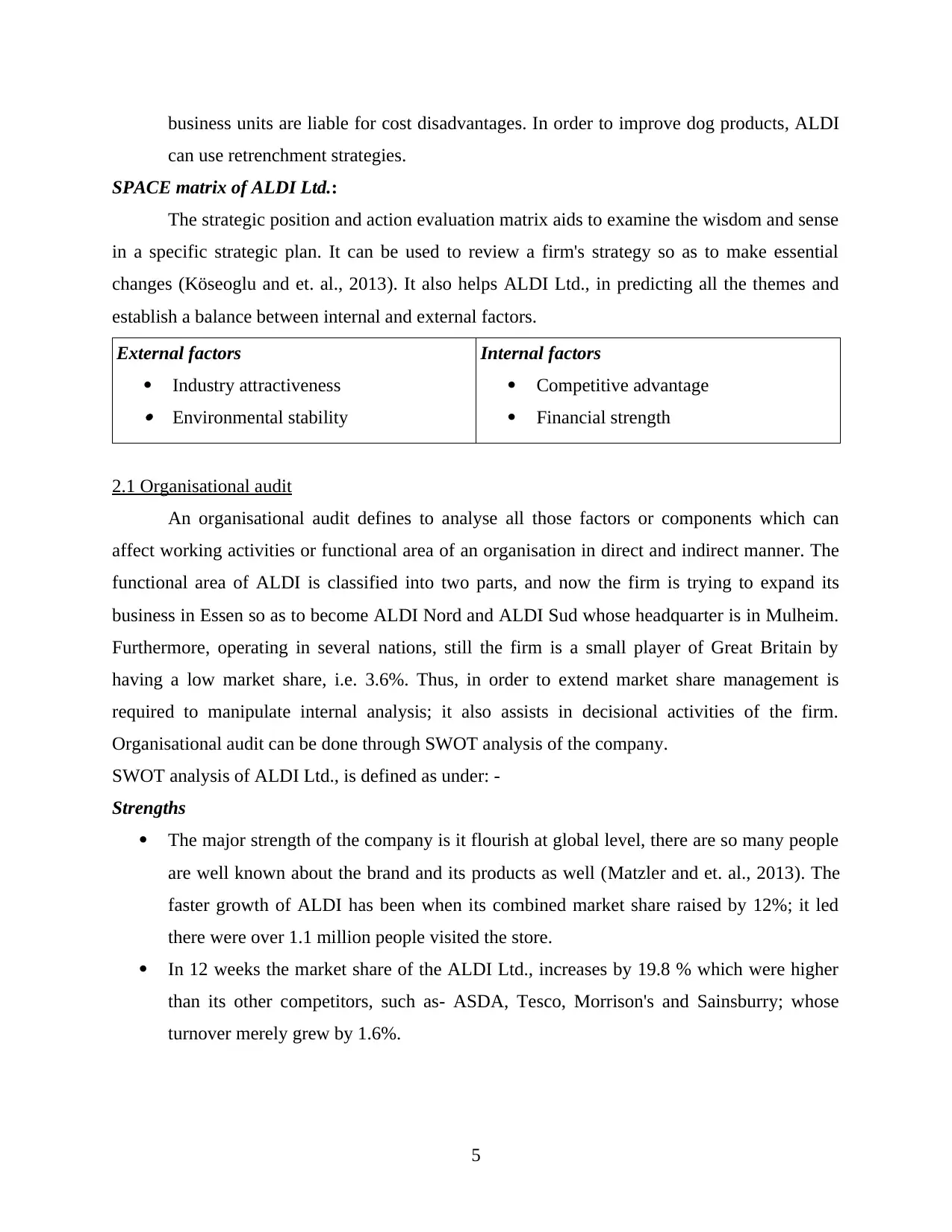
business units are liable for cost disadvantages. In order to improve dog products, ALDI
can use retrenchment strategies.
SPACE matrix of ALDI Ltd.:
The strategic position and action evaluation matrix aids to examine the wisdom and sense
in a specific strategic plan. It can be used to review a firm's strategy so as to make essential
changes (Köseoglu and et. al., 2013). It also helps ALDI Ltd., in predicting all the themes and
establish a balance between internal and external factors.
External factors
Industry attractiveness Environmental stability
Internal factors
Competitive advantage
Financial strength
2.1 Organisational audit
An organisational audit defines to analyse all those factors or components which can
affect working activities or functional area of an organisation in direct and indirect manner. The
functional area of ALDI is classified into two parts, and now the firm is trying to expand its
business in Essen so as to become ALDI Nord and ALDI Sud whose headquarter is in Mulheim.
Furthermore, operating in several nations, still the firm is a small player of Great Britain by
having a low market share, i.e. 3.6%. Thus, in order to extend market share management is
required to manipulate internal analysis; it also assists in decisional activities of the firm.
Organisational audit can be done through SWOT analysis of the company.
SWOT analysis of ALDI Ltd., is defined as under: -
Strengths
The major strength of the company is it flourish at global level, there are so many people
are well known about the brand and its products as well (Matzler and et. al., 2013). The
faster growth of ALDI has been when its combined market share raised by 12%; it led
there were over 1.1 million people visited the store.
In 12 weeks the market share of the ALDI Ltd., increases by 19.8 % which were higher
than its other competitors, such as- ASDA, Tesco, Morrison's and Sainsburry; whose
turnover merely grew by 1.6%.
5
can use retrenchment strategies.
SPACE matrix of ALDI Ltd.:
The strategic position and action evaluation matrix aids to examine the wisdom and sense
in a specific strategic plan. It can be used to review a firm's strategy so as to make essential
changes (Köseoglu and et. al., 2013). It also helps ALDI Ltd., in predicting all the themes and
establish a balance between internal and external factors.
External factors
Industry attractiveness Environmental stability
Internal factors
Competitive advantage
Financial strength
2.1 Organisational audit
An organisational audit defines to analyse all those factors or components which can
affect working activities or functional area of an organisation in direct and indirect manner. The
functional area of ALDI is classified into two parts, and now the firm is trying to expand its
business in Essen so as to become ALDI Nord and ALDI Sud whose headquarter is in Mulheim.
Furthermore, operating in several nations, still the firm is a small player of Great Britain by
having a low market share, i.e. 3.6%. Thus, in order to extend market share management is
required to manipulate internal analysis; it also assists in decisional activities of the firm.
Organisational audit can be done through SWOT analysis of the company.
SWOT analysis of ALDI Ltd., is defined as under: -
Strengths
The major strength of the company is it flourish at global level, there are so many people
are well known about the brand and its products as well (Matzler and et. al., 2013). The
faster growth of ALDI has been when its combined market share raised by 12%; it led
there were over 1.1 million people visited the store.
In 12 weeks the market share of the ALDI Ltd., increases by 19.8 % which were higher
than its other competitors, such as- ASDA, Tesco, Morrison's and Sainsburry; whose
turnover merely grew by 1.6%.
5
Paraphrase This Document
Need a fresh take? Get an instant paraphrase of this document with our AI Paraphraser
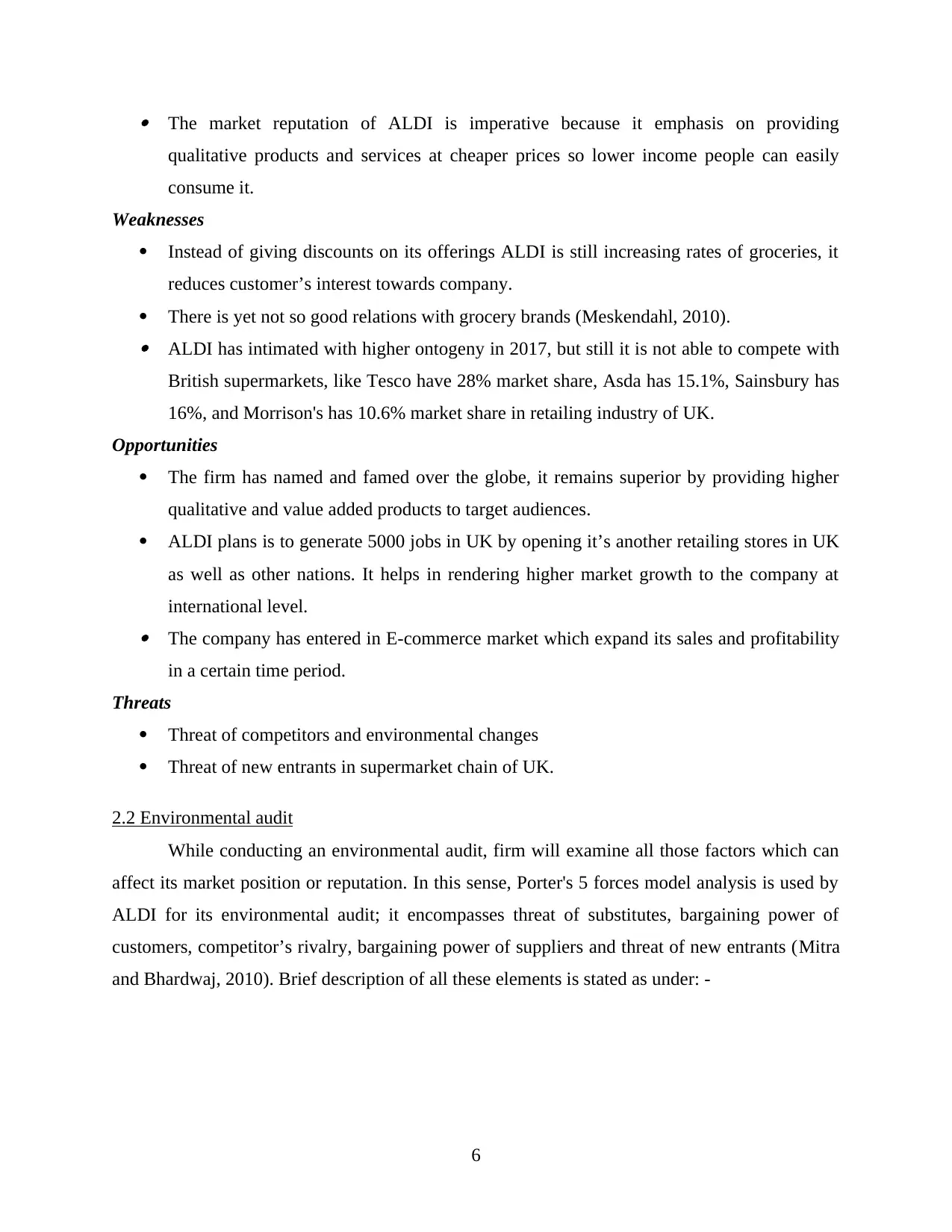
The market reputation of ALDI is imperative because it emphasis on providing
qualitative products and services at cheaper prices so lower income people can easily
consume it.
Weaknesses
Instead of giving discounts on its offerings ALDI is still increasing rates of groceries, it
reduces customer’s interest towards company.
There is yet not so good relations with grocery brands (Meskendahl, 2010). ALDI has intimated with higher ontogeny in 2017, but still it is not able to compete with
British supermarkets, like Tesco have 28% market share, Asda has 15.1%, Sainsbury has
16%, and Morrison's has 10.6% market share in retailing industry of UK.
Opportunities
The firm has named and famed over the globe, it remains superior by providing higher
qualitative and value added products to target audiences.
ALDI plans is to generate 5000 jobs in UK by opening it’s another retailing stores in UK
as well as other nations. It helps in rendering higher market growth to the company at
international level. The company has entered in E-commerce market which expand its sales and profitability
in a certain time period.
Threats
Threat of competitors and environmental changes
Threat of new entrants in supermarket chain of UK.
2.2 Environmental audit
While conducting an environmental audit, firm will examine all those factors which can
affect its market position or reputation. In this sense, Porter's 5 forces model analysis is used by
ALDI for its environmental audit; it encompasses threat of substitutes, bargaining power of
customers, competitor’s rivalry, bargaining power of suppliers and threat of new entrants (Mitra
and Bhardwaj, 2010). Brief description of all these elements is stated as under: -
6
qualitative products and services at cheaper prices so lower income people can easily
consume it.
Weaknesses
Instead of giving discounts on its offerings ALDI is still increasing rates of groceries, it
reduces customer’s interest towards company.
There is yet not so good relations with grocery brands (Meskendahl, 2010). ALDI has intimated with higher ontogeny in 2017, but still it is not able to compete with
British supermarkets, like Tesco have 28% market share, Asda has 15.1%, Sainsbury has
16%, and Morrison's has 10.6% market share in retailing industry of UK.
Opportunities
The firm has named and famed over the globe, it remains superior by providing higher
qualitative and value added products to target audiences.
ALDI plans is to generate 5000 jobs in UK by opening it’s another retailing stores in UK
as well as other nations. It helps in rendering higher market growth to the company at
international level. The company has entered in E-commerce market which expand its sales and profitability
in a certain time period.
Threats
Threat of competitors and environmental changes
Threat of new entrants in supermarket chain of UK.
2.2 Environmental audit
While conducting an environmental audit, firm will examine all those factors which can
affect its market position or reputation. In this sense, Porter's 5 forces model analysis is used by
ALDI for its environmental audit; it encompasses threat of substitutes, bargaining power of
customers, competitor’s rivalry, bargaining power of suppliers and threat of new entrants (Mitra
and Bhardwaj, 2010). Brief description of all these elements is stated as under: -
6
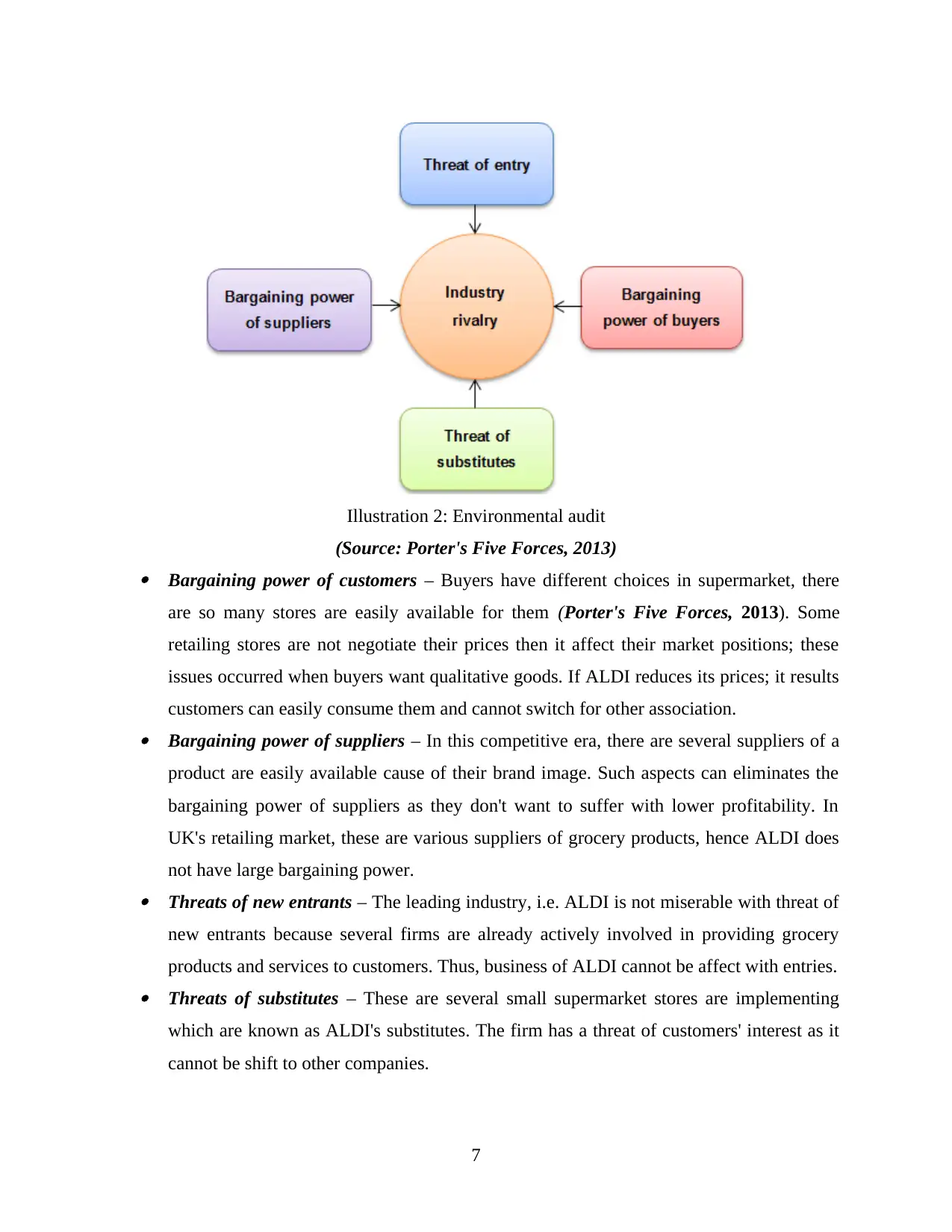
(Source: Porter's Five Forces, 2013) Bargaining power of customers – Buyers have different choices in supermarket, there
are so many stores are easily available for them (Porter's Five Forces, 2013). Some
retailing stores are not negotiate their prices then it affect their market positions; these
issues occurred when buyers want qualitative goods. If ALDI reduces its prices; it results
customers can easily consume them and cannot switch for other association. Bargaining power of suppliers – In this competitive era, there are several suppliers of a
product are easily available cause of their brand image. Such aspects can eliminates the
bargaining power of suppliers as they don't want to suffer with lower profitability. In
UK's retailing market, these are various suppliers of grocery products, hence ALDI does
not have large bargaining power. Threats of new entrants – The leading industry, i.e. ALDI is not miserable with threat of
new entrants because several firms are already actively involved in providing grocery
products and services to customers. Thus, business of ALDI cannot be affect with entries. Threats of substitutes – These are several small supermarket stores are implementing
which are known as ALDI's substitutes. The firm has a threat of customers' interest as it
cannot be shift to other companies.
7
Illustration 2: Environmental audit
are so many stores are easily available for them (Porter's Five Forces, 2013). Some
retailing stores are not negotiate their prices then it affect their market positions; these
issues occurred when buyers want qualitative goods. If ALDI reduces its prices; it results
customers can easily consume them and cannot switch for other association. Bargaining power of suppliers – In this competitive era, there are several suppliers of a
product are easily available cause of their brand image. Such aspects can eliminates the
bargaining power of suppliers as they don't want to suffer with lower profitability. In
UK's retailing market, these are various suppliers of grocery products, hence ALDI does
not have large bargaining power. Threats of new entrants – The leading industry, i.e. ALDI is not miserable with threat of
new entrants because several firms are already actively involved in providing grocery
products and services to customers. Thus, business of ALDI cannot be affect with entries. Threats of substitutes – These are several small supermarket stores are implementing
which are known as ALDI's substitutes. The firm has a threat of customers' interest as it
cannot be shift to other companies.
7
Illustration 2: Environmental audit
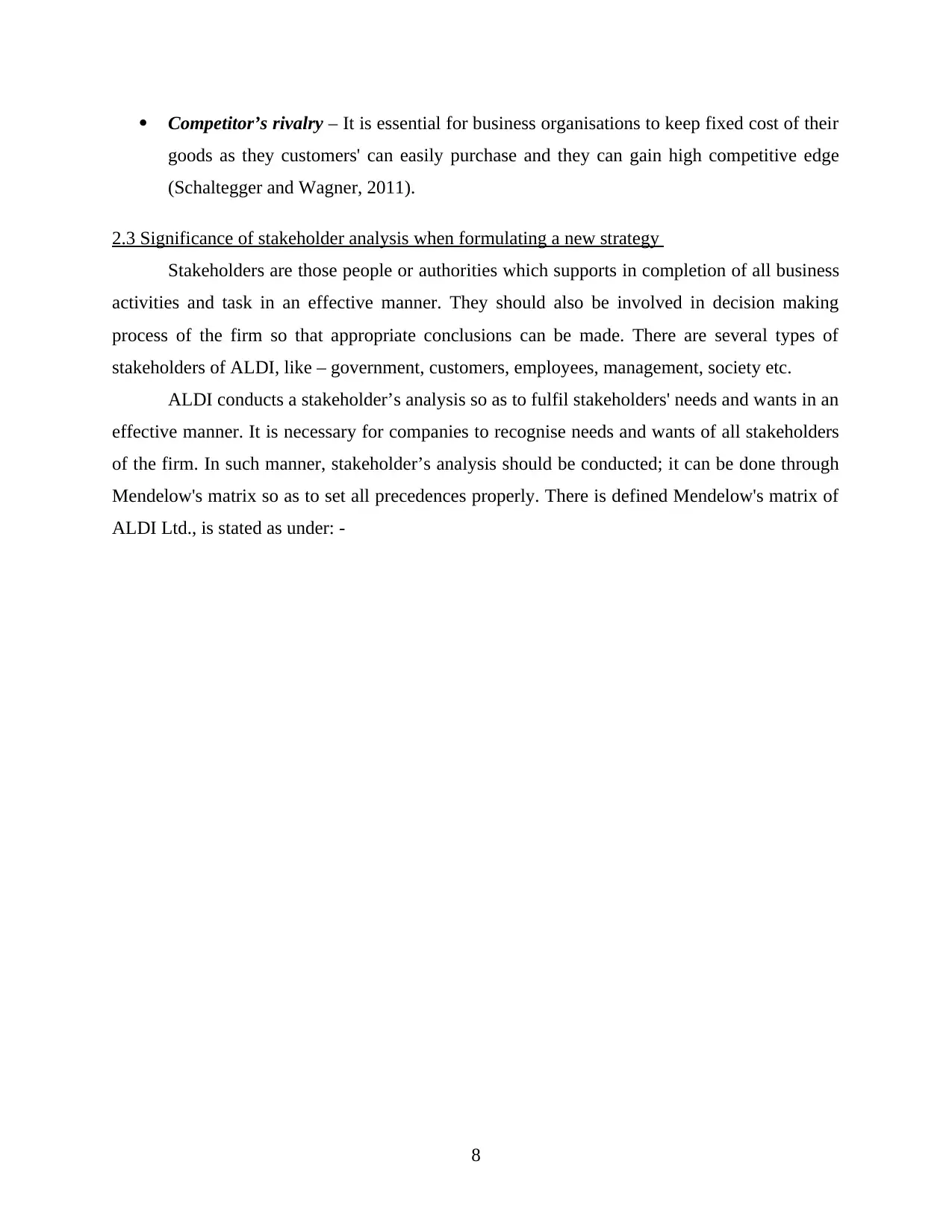
Competitor’s rivalry – It is essential for business organisations to keep fixed cost of their
goods as they customers' can easily purchase and they can gain high competitive edge
(Schaltegger and Wagner, 2011).
2.3 Significance of stakeholder analysis when formulating a new strategy
Stakeholders are those people or authorities which supports in completion of all business
activities and task in an effective manner. They should also be involved in decision making
process of the firm so that appropriate conclusions can be made. There are several types of
stakeholders of ALDI, like – government, customers, employees, management, society etc.
ALDI conducts a stakeholder’s analysis so as to fulfil stakeholders' needs and wants in an
effective manner. It is necessary for companies to recognise needs and wants of all stakeholders
of the firm. In such manner, stakeholder’s analysis should be conducted; it can be done through
Mendelow's matrix so as to set all precedences properly. There is defined Mendelow's matrix of
ALDI Ltd., is stated as under: -
8
goods as they customers' can easily purchase and they can gain high competitive edge
(Schaltegger and Wagner, 2011).
2.3 Significance of stakeholder analysis when formulating a new strategy
Stakeholders are those people or authorities which supports in completion of all business
activities and task in an effective manner. They should also be involved in decision making
process of the firm so that appropriate conclusions can be made. There are several types of
stakeholders of ALDI, like – government, customers, employees, management, society etc.
ALDI conducts a stakeholder’s analysis so as to fulfil stakeholders' needs and wants in an
effective manner. It is necessary for companies to recognise needs and wants of all stakeholders
of the firm. In such manner, stakeholder’s analysis should be conducted; it can be done through
Mendelow's matrix so as to set all precedences properly. There is defined Mendelow's matrix of
ALDI Ltd., is stated as under: -
8
Secure Best Marks with AI Grader
Need help grading? Try our AI Grader for instant feedback on your assignments.
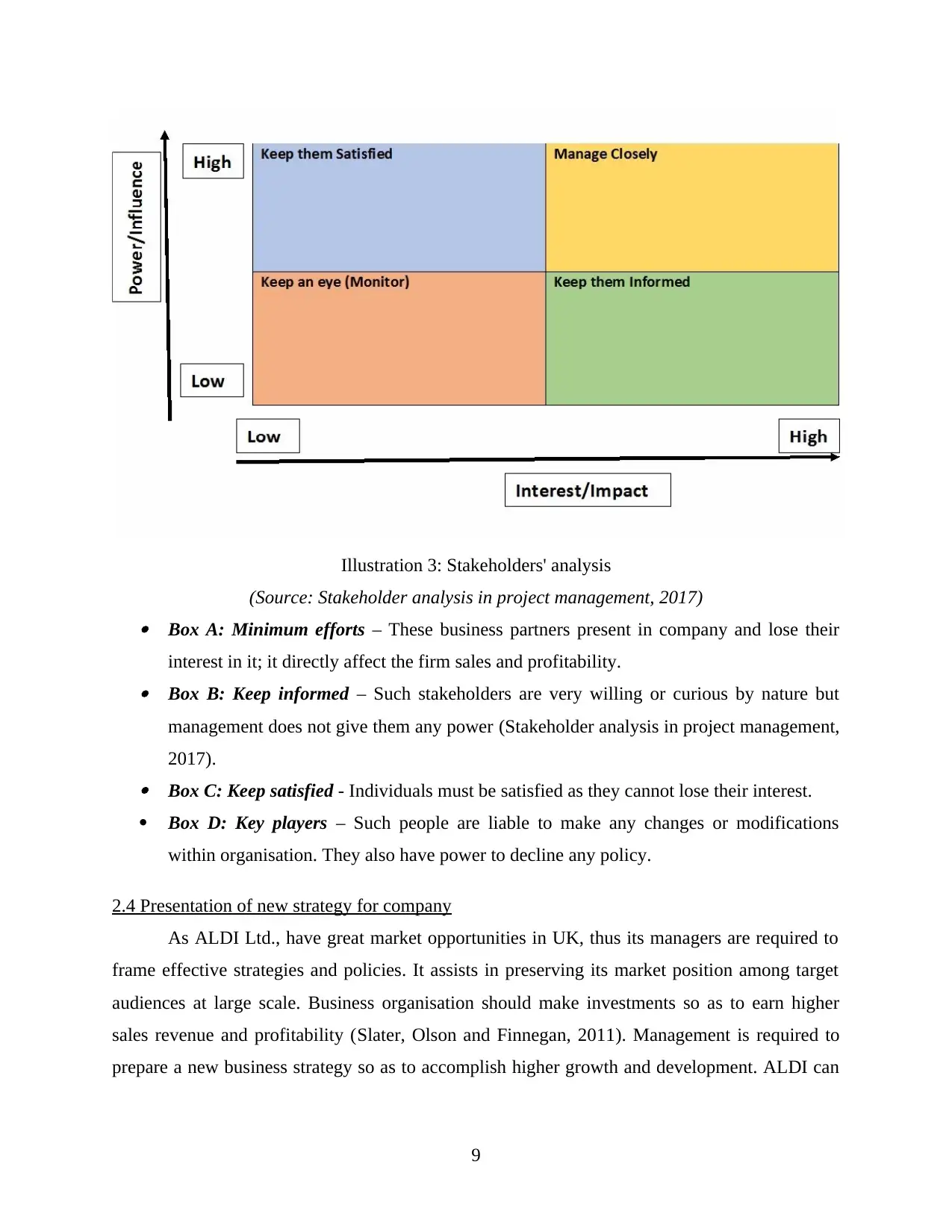
(Source: Stakeholder analysis in project management, 2017) Box A: Minimum efforts – These business partners present in company and lose their
interest in it; it directly affect the firm sales and profitability. Box B: Keep informed – Such stakeholders are very willing or curious by nature but
management does not give them any power (Stakeholder analysis in project management,
2017). Box C: Keep satisfied - Individuals must be satisfied as they cannot lose their interest.
Box D: Key players – Such people are liable to make any changes or modifications
within organisation. They also have power to decline any policy.
2.4 Presentation of new strategy for company
As ALDI Ltd., have great market opportunities in UK, thus its managers are required to
frame effective strategies and policies. It assists in preserving its market position among target
audiences at large scale. Business organisation should make investments so as to earn higher
sales revenue and profitability (Slater, Olson and Finnegan, 2011). Management is required to
prepare a new business strategy so as to accomplish higher growth and development. ALDI can
9
Illustration 3: Stakeholders' analysis
interest in it; it directly affect the firm sales and profitability. Box B: Keep informed – Such stakeholders are very willing or curious by nature but
management does not give them any power (Stakeholder analysis in project management,
2017). Box C: Keep satisfied - Individuals must be satisfied as they cannot lose their interest.
Box D: Key players – Such people are liable to make any changes or modifications
within organisation. They also have power to decline any policy.
2.4 Presentation of new strategy for company
As ALDI Ltd., have great market opportunities in UK, thus its managers are required to
frame effective strategies and policies. It assists in preserving its market position among target
audiences at large scale. Business organisation should make investments so as to earn higher
sales revenue and profitability (Slater, Olson and Finnegan, 2011). Management is required to
prepare a new business strategy so as to accomplish higher growth and development. ALDI can
9
Illustration 3: Stakeholders' analysis
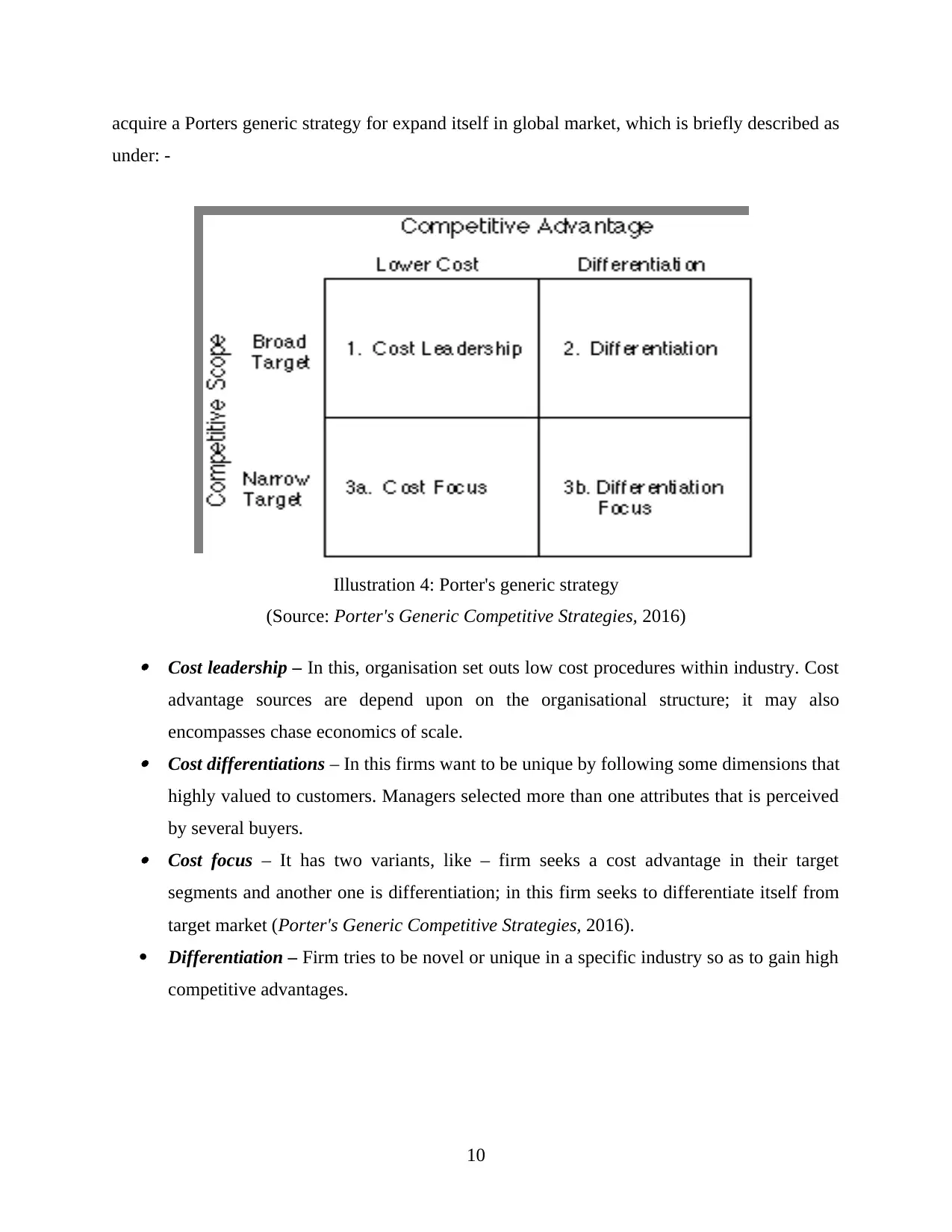
acquire a Porters generic strategy for expand itself in global market, which is briefly described as
under: -
(Source: Porter's Generic Competitive Strategies, 2016)
Cost leadership – In this, organisation set outs low cost procedures within industry. Cost
advantage sources are depend upon on the organisational structure; it may also
encompasses chase economics of scale. Cost differentiations – In this firms want to be unique by following some dimensions that
highly valued to customers. Managers selected more than one attributes that is perceived
by several buyers. Cost focus – It has two variants, like – firm seeks a cost advantage in their target
segments and another one is differentiation; in this firm seeks to differentiate itself from
target market (Porter's Generic Competitive Strategies, 2016).
Differentiation – Firm tries to be novel or unique in a specific industry so as to gain high
competitive advantages.
10
Illustration 4: Porter's generic strategy
under: -
(Source: Porter's Generic Competitive Strategies, 2016)
Cost leadership – In this, organisation set outs low cost procedures within industry. Cost
advantage sources are depend upon on the organisational structure; it may also
encompasses chase economics of scale. Cost differentiations – In this firms want to be unique by following some dimensions that
highly valued to customers. Managers selected more than one attributes that is perceived
by several buyers. Cost focus – It has two variants, like – firm seeks a cost advantage in their target
segments and another one is differentiation; in this firm seeks to differentiate itself from
target market (Porter's Generic Competitive Strategies, 2016).
Differentiation – Firm tries to be novel or unique in a specific industry so as to gain high
competitive advantages.
10
Illustration 4: Porter's generic strategy
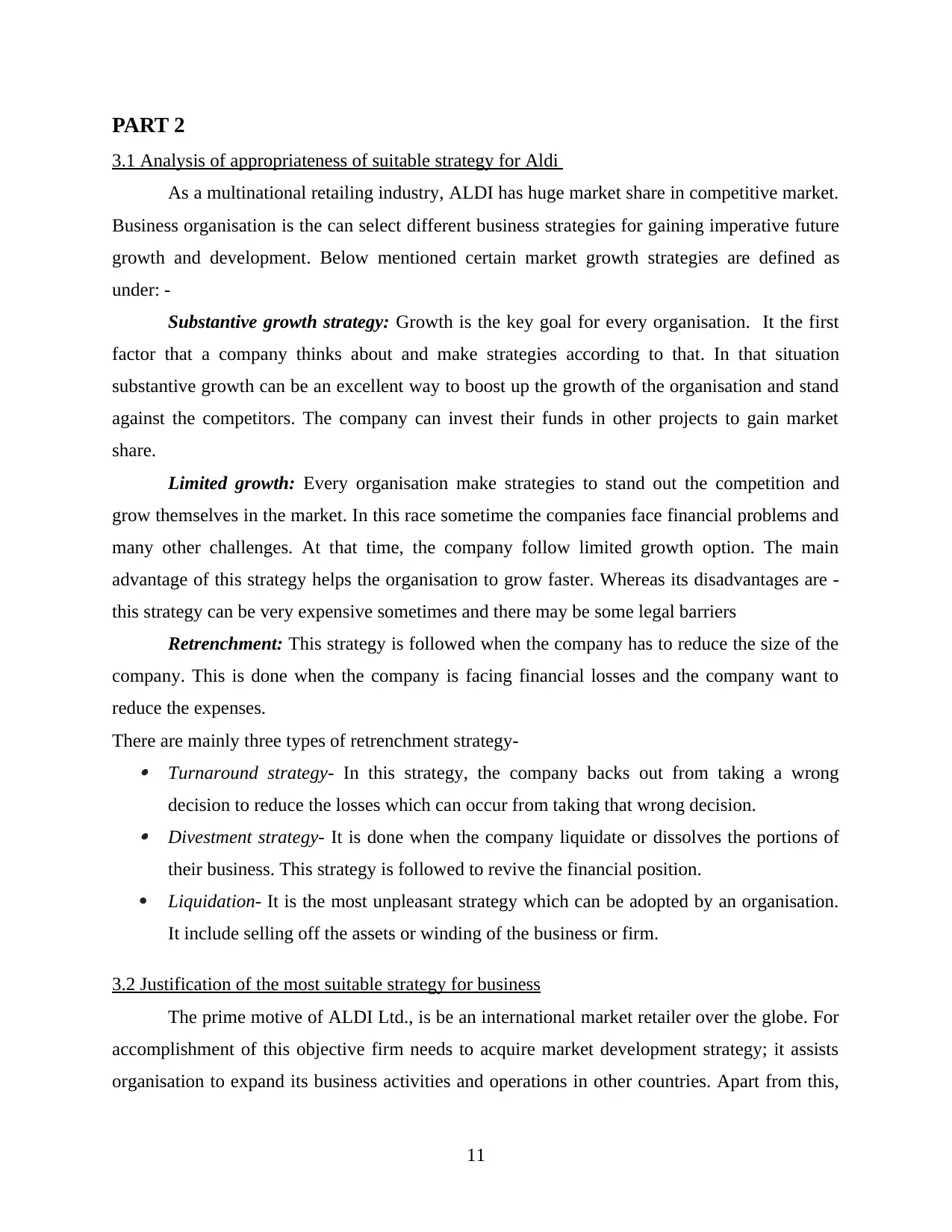
PART 2
3.1 Analysis of appropriateness of suitable strategy for Aldi
As a multinational retailing industry, ALDI has huge market share in competitive market.
Business organisation is the can select different business strategies for gaining imperative future
growth and development. Below mentioned certain market growth strategies are defined as
under: -
Substantive growth strategy: Growth is the key goal for every organisation. It the first
factor that a company thinks about and make strategies according to that. In that situation
substantive growth can be an excellent way to boost up the growth of the organisation and stand
against the competitors. The company can invest their funds in other projects to gain market
share.
Limited growth: Every organisation make strategies to stand out the competition and
grow themselves in the market. In this race sometime the companies face financial problems and
many other challenges. At that time, the company follow limited growth option. The main
advantage of this strategy helps the organisation to grow faster. Whereas its disadvantages are -
this strategy can be very expensive sometimes and there may be some legal barriers
Retrenchment: This strategy is followed when the company has to reduce the size of the
company. This is done when the company is facing financial losses and the company want to
reduce the expenses.
There are mainly three types of retrenchment strategy- Turnaround strategy- In this strategy, the company backs out from taking a wrong
decision to reduce the losses which can occur from taking that wrong decision. Divestment strategy- It is done when the company liquidate or dissolves the portions of
their business. This strategy is followed to revive the financial position.
Liquidation- It is the most unpleasant strategy which can be adopted by an organisation.
It include selling off the assets or winding of the business or firm.
3.2 Justification of the most suitable strategy for business
The prime motive of ALDI Ltd., is be an international market retailer over the globe. For
accomplishment of this objective firm needs to acquire market development strategy; it assists
organisation to expand its business activities and operations in other countries. Apart from this,
11
3.1 Analysis of appropriateness of suitable strategy for Aldi
As a multinational retailing industry, ALDI has huge market share in competitive market.
Business organisation is the can select different business strategies for gaining imperative future
growth and development. Below mentioned certain market growth strategies are defined as
under: -
Substantive growth strategy: Growth is the key goal for every organisation. It the first
factor that a company thinks about and make strategies according to that. In that situation
substantive growth can be an excellent way to boost up the growth of the organisation and stand
against the competitors. The company can invest their funds in other projects to gain market
share.
Limited growth: Every organisation make strategies to stand out the competition and
grow themselves in the market. In this race sometime the companies face financial problems and
many other challenges. At that time, the company follow limited growth option. The main
advantage of this strategy helps the organisation to grow faster. Whereas its disadvantages are -
this strategy can be very expensive sometimes and there may be some legal barriers
Retrenchment: This strategy is followed when the company has to reduce the size of the
company. This is done when the company is facing financial losses and the company want to
reduce the expenses.
There are mainly three types of retrenchment strategy- Turnaround strategy- In this strategy, the company backs out from taking a wrong
decision to reduce the losses which can occur from taking that wrong decision. Divestment strategy- It is done when the company liquidate or dissolves the portions of
their business. This strategy is followed to revive the financial position.
Liquidation- It is the most unpleasant strategy which can be adopted by an organisation.
It include selling off the assets or winding of the business or firm.
3.2 Justification of the most suitable strategy for business
The prime motive of ALDI Ltd., is be an international market retailer over the globe. For
accomplishment of this objective firm needs to acquire market development strategy; it assists
organisation to expand its business activities and operations in other countries. Apart from this,
11
Paraphrase This Document
Need a fresh take? Get an instant paraphrase of this document with our AI Paraphraser
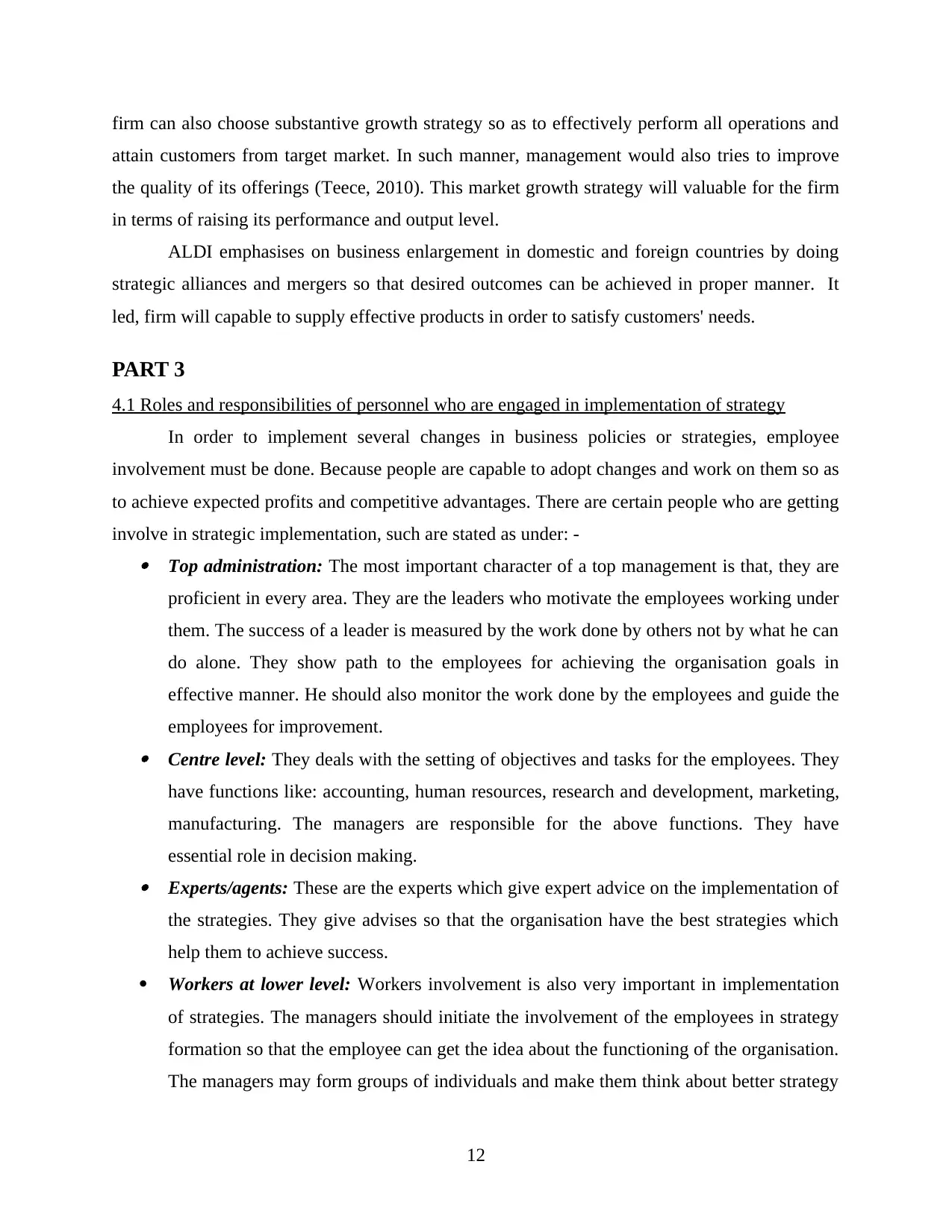
firm can also choose substantive growth strategy so as to effectively perform all operations and
attain customers from target market. In such manner, management would also tries to improve
the quality of its offerings (Teece, 2010). This market growth strategy will valuable for the firm
in terms of raising its performance and output level.
ALDI emphasises on business enlargement in domestic and foreign countries by doing
strategic alliances and mergers so that desired outcomes can be achieved in proper manner. It
led, firm will capable to supply effective products in order to satisfy customers' needs.
PART 3
4.1 Roles and responsibilities of personnel who are engaged in implementation of strategy
In order to implement several changes in business policies or strategies, employee
involvement must be done. Because people are capable to adopt changes and work on them so as
to achieve expected profits and competitive advantages. There are certain people who are getting
involve in strategic implementation, such are stated as under: - Top administration: The most important character of a top management is that, they are
proficient in every area. They are the leaders who motivate the employees working under
them. The success of a leader is measured by the work done by others not by what he can
do alone. They show path to the employees for achieving the organisation goals in
effective manner. He should also monitor the work done by the employees and guide the
employees for improvement. Centre level: They deals with the setting of objectives and tasks for the employees. They
have functions like: accounting, human resources, research and development, marketing,
manufacturing. The managers are responsible for the above functions. They have
essential role in decision making. Experts/agents: These are the experts which give expert advice on the implementation of
the strategies. They give advises so that the organisation have the best strategies which
help them to achieve success.
Workers at lower level: Workers involvement is also very important in implementation
of strategies. The managers should initiate the involvement of the employees in strategy
formation so that the employee can get the idea about the functioning of the organisation.
The managers may form groups of individuals and make them think about better strategy
12
attain customers from target market. In such manner, management would also tries to improve
the quality of its offerings (Teece, 2010). This market growth strategy will valuable for the firm
in terms of raising its performance and output level.
ALDI emphasises on business enlargement in domestic and foreign countries by doing
strategic alliances and mergers so that desired outcomes can be achieved in proper manner. It
led, firm will capable to supply effective products in order to satisfy customers' needs.
PART 3
4.1 Roles and responsibilities of personnel who are engaged in implementation of strategy
In order to implement several changes in business policies or strategies, employee
involvement must be done. Because people are capable to adopt changes and work on them so as
to achieve expected profits and competitive advantages. There are certain people who are getting
involve in strategic implementation, such are stated as under: - Top administration: The most important character of a top management is that, they are
proficient in every area. They are the leaders who motivate the employees working under
them. The success of a leader is measured by the work done by others not by what he can
do alone. They show path to the employees for achieving the organisation goals in
effective manner. He should also monitor the work done by the employees and guide the
employees for improvement. Centre level: They deals with the setting of objectives and tasks for the employees. They
have functions like: accounting, human resources, research and development, marketing,
manufacturing. The managers are responsible for the above functions. They have
essential role in decision making. Experts/agents: These are the experts which give expert advice on the implementation of
the strategies. They give advises so that the organisation have the best strategies which
help them to achieve success.
Workers at lower level: Workers involvement is also very important in implementation
of strategies. The managers should initiate the involvement of the employees in strategy
formation so that the employee can get the idea about the functioning of the organisation.
The managers may form groups of individuals and make them think about better strategy
12
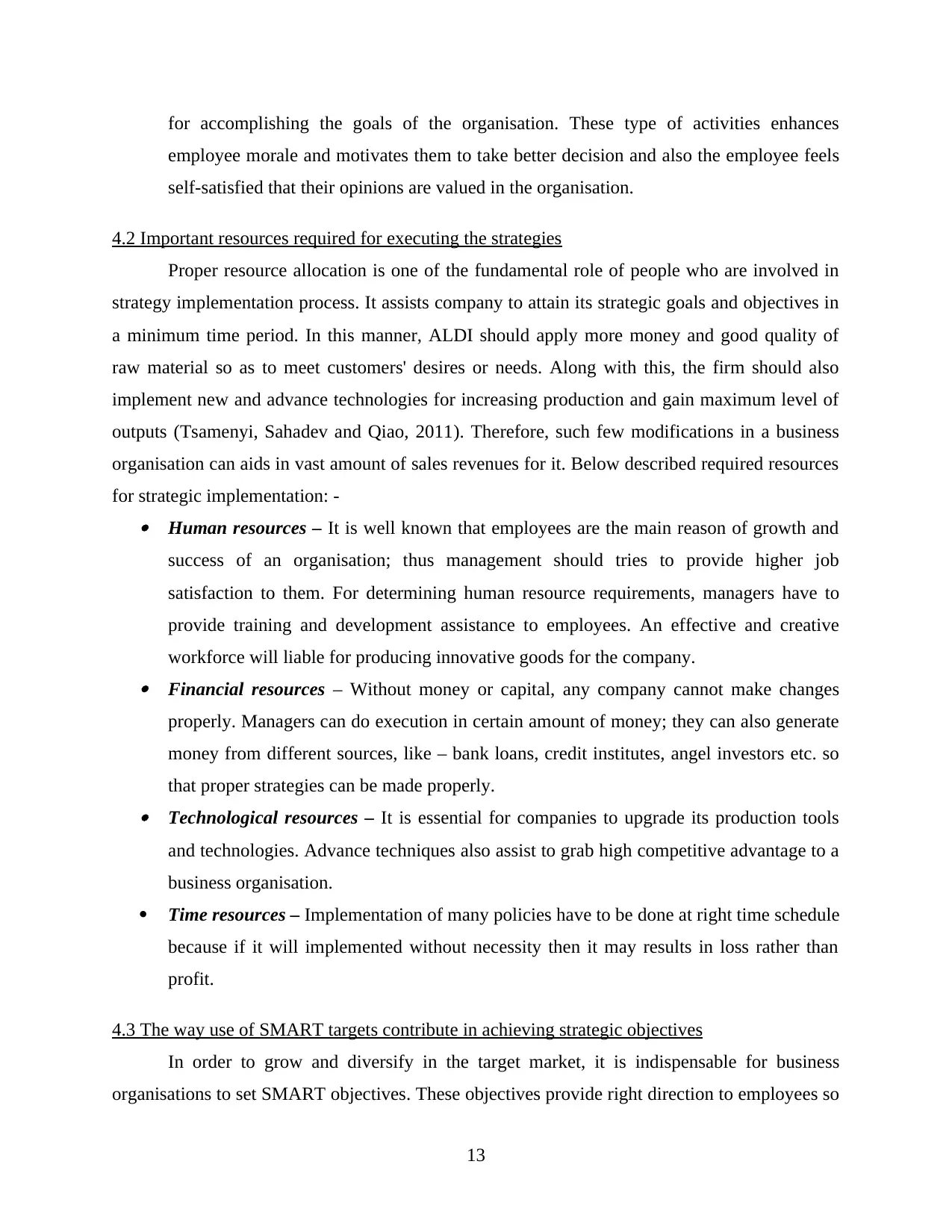
for accomplishing the goals of the organisation. These type of activities enhances
employee morale and motivates them to take better decision and also the employee feels
self-satisfied that their opinions are valued in the organisation.
4.2 Important resources required for executing the strategies
Proper resource allocation is one of the fundamental role of people who are involved in
strategy implementation process. It assists company to attain its strategic goals and objectives in
a minimum time period. In this manner, ALDI should apply more money and good quality of
raw material so as to meet customers' desires or needs. Along with this, the firm should also
implement new and advance technologies for increasing production and gain maximum level of
outputs (Tsamenyi, Sahadev and Qiao, 2011). Therefore, such few modifications in a business
organisation can aids in vast amount of sales revenues for it. Below described required resources
for strategic implementation: - Human resources – It is well known that employees are the main reason of growth and
success of an organisation; thus management should tries to provide higher job
satisfaction to them. For determining human resource requirements, managers have to
provide training and development assistance to employees. An effective and creative
workforce will liable for producing innovative goods for the company. Financial resources – Without money or capital, any company cannot make changes
properly. Managers can do execution in certain amount of money; they can also generate
money from different sources, like – bank loans, credit institutes, angel investors etc. so
that proper strategies can be made properly. Technological resources – It is essential for companies to upgrade its production tools
and technologies. Advance techniques also assist to grab high competitive advantage to a
business organisation.
Time resources – Implementation of many policies have to be done at right time schedule
because if it will implemented without necessity then it may results in loss rather than
profit.
4.3 The way use of SMART targets contribute in achieving strategic objectives
In order to grow and diversify in the target market, it is indispensable for business
organisations to set SMART objectives. These objectives provide right direction to employees so
13
employee morale and motivates them to take better decision and also the employee feels
self-satisfied that their opinions are valued in the organisation.
4.2 Important resources required for executing the strategies
Proper resource allocation is one of the fundamental role of people who are involved in
strategy implementation process. It assists company to attain its strategic goals and objectives in
a minimum time period. In this manner, ALDI should apply more money and good quality of
raw material so as to meet customers' desires or needs. Along with this, the firm should also
implement new and advance technologies for increasing production and gain maximum level of
outputs (Tsamenyi, Sahadev and Qiao, 2011). Therefore, such few modifications in a business
organisation can aids in vast amount of sales revenues for it. Below described required resources
for strategic implementation: - Human resources – It is well known that employees are the main reason of growth and
success of an organisation; thus management should tries to provide higher job
satisfaction to them. For determining human resource requirements, managers have to
provide training and development assistance to employees. An effective and creative
workforce will liable for producing innovative goods for the company. Financial resources – Without money or capital, any company cannot make changes
properly. Managers can do execution in certain amount of money; they can also generate
money from different sources, like – bank loans, credit institutes, angel investors etc. so
that proper strategies can be made properly. Technological resources – It is essential for companies to upgrade its production tools
and technologies. Advance techniques also assist to grab high competitive advantage to a
business organisation.
Time resources – Implementation of many policies have to be done at right time schedule
because if it will implemented without necessity then it may results in loss rather than
profit.
4.3 The way use of SMART targets contribute in achieving strategic objectives
In order to grow and diversify in the target market, it is indispensable for business
organisations to set SMART objectives. These objectives provide right direction to employees so
13
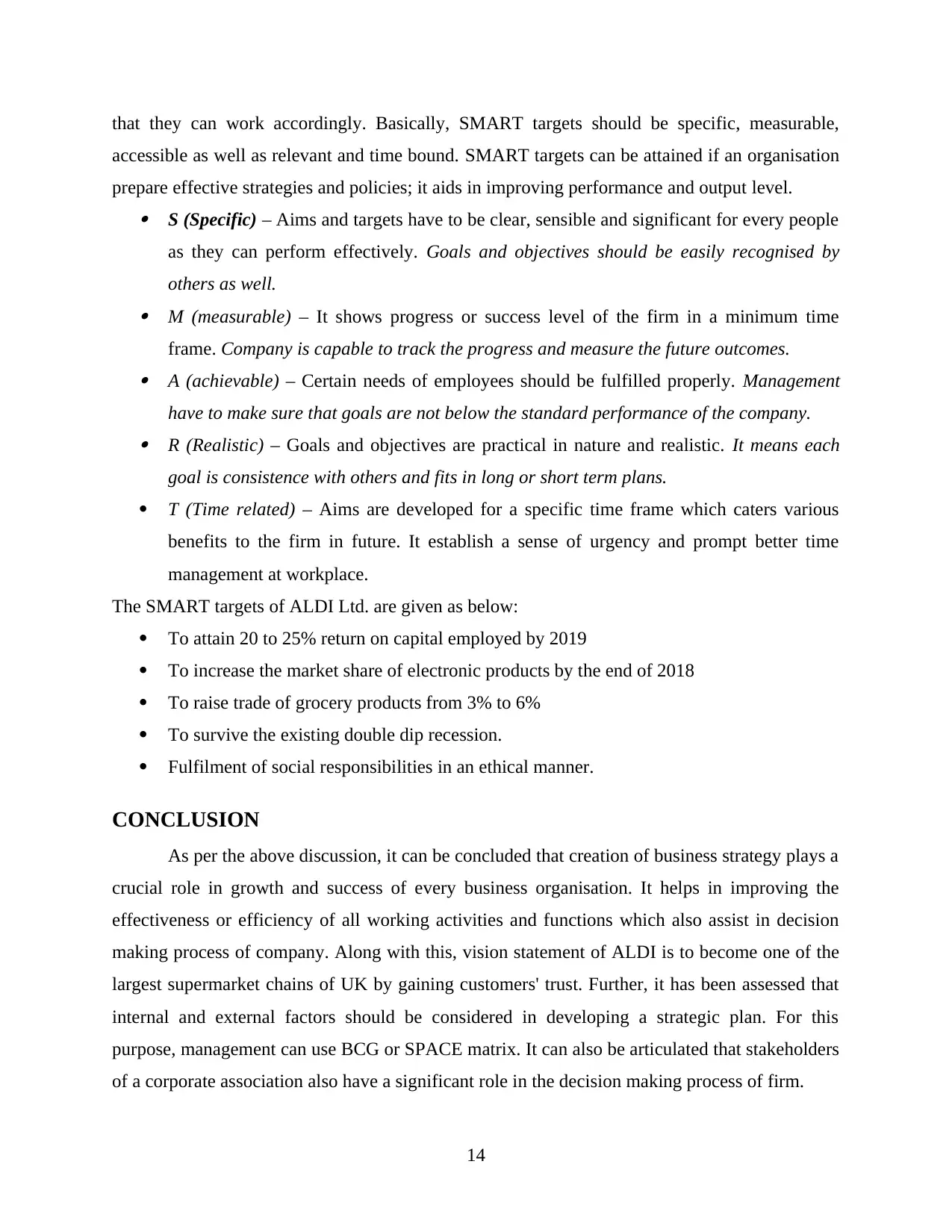
that they can work accordingly. Basically, SMART targets should be specific, measurable,
accessible as well as relevant and time bound. SMART targets can be attained if an organisation
prepare effective strategies and policies; it aids in improving performance and output level. S (Specific) – Aims and targets have to be clear, sensible and significant for every people
as they can perform effectively. Goals and objectives should be easily recognised by
others as well. M (measurable) – It shows progress or success level of the firm in a minimum time
frame. Company is capable to track the progress and measure the future outcomes. A (achievable) – Certain needs of employees should be fulfilled properly. Management
have to make sure that goals are not below the standard performance of the company. R (Realistic) – Goals and objectives are practical in nature and realistic. It means each
goal is consistence with others and fits in long or short term plans.
T (Time related) – Aims are developed for a specific time frame which caters various
benefits to the firm in future. It establish a sense of urgency and prompt better time
management at workplace.
The SMART targets of ALDI Ltd. are given as below:
To attain 20 to 25% return on capital employed by 2019
To increase the market share of electronic products by the end of 2018
To raise trade of grocery products from 3% to 6%
To survive the existing double dip recession.
Fulfilment of social responsibilities in an ethical manner.
CONCLUSION
As per the above discussion, it can be concluded that creation of business strategy plays a
crucial role in growth and success of every business organisation. It helps in improving the
effectiveness or efficiency of all working activities and functions which also assist in decision
making process of company. Along with this, vision statement of ALDI is to become one of the
largest supermarket chains of UK by gaining customers' trust. Further, it has been assessed that
internal and external factors should be considered in developing a strategic plan. For this
purpose, management can use BCG or SPACE matrix. It can also be articulated that stakeholders
of a corporate association also have a significant role in the decision making process of firm.
14
accessible as well as relevant and time bound. SMART targets can be attained if an organisation
prepare effective strategies and policies; it aids in improving performance and output level. S (Specific) – Aims and targets have to be clear, sensible and significant for every people
as they can perform effectively. Goals and objectives should be easily recognised by
others as well. M (measurable) – It shows progress or success level of the firm in a minimum time
frame. Company is capable to track the progress and measure the future outcomes. A (achievable) – Certain needs of employees should be fulfilled properly. Management
have to make sure that goals are not below the standard performance of the company. R (Realistic) – Goals and objectives are practical in nature and realistic. It means each
goal is consistence with others and fits in long or short term plans.
T (Time related) – Aims are developed for a specific time frame which caters various
benefits to the firm in future. It establish a sense of urgency and prompt better time
management at workplace.
The SMART targets of ALDI Ltd. are given as below:
To attain 20 to 25% return on capital employed by 2019
To increase the market share of electronic products by the end of 2018
To raise trade of grocery products from 3% to 6%
To survive the existing double dip recession.
Fulfilment of social responsibilities in an ethical manner.
CONCLUSION
As per the above discussion, it can be concluded that creation of business strategy plays a
crucial role in growth and success of every business organisation. It helps in improving the
effectiveness or efficiency of all working activities and functions which also assist in decision
making process of company. Along with this, vision statement of ALDI is to become one of the
largest supermarket chains of UK by gaining customers' trust. Further, it has been assessed that
internal and external factors should be considered in developing a strategic plan. For this
purpose, management can use BCG or SPACE matrix. It can also be articulated that stakeholders
of a corporate association also have a significant role in the decision making process of firm.
14
Secure Best Marks with AI Grader
Need help grading? Try our AI Grader for instant feedback on your assignments.
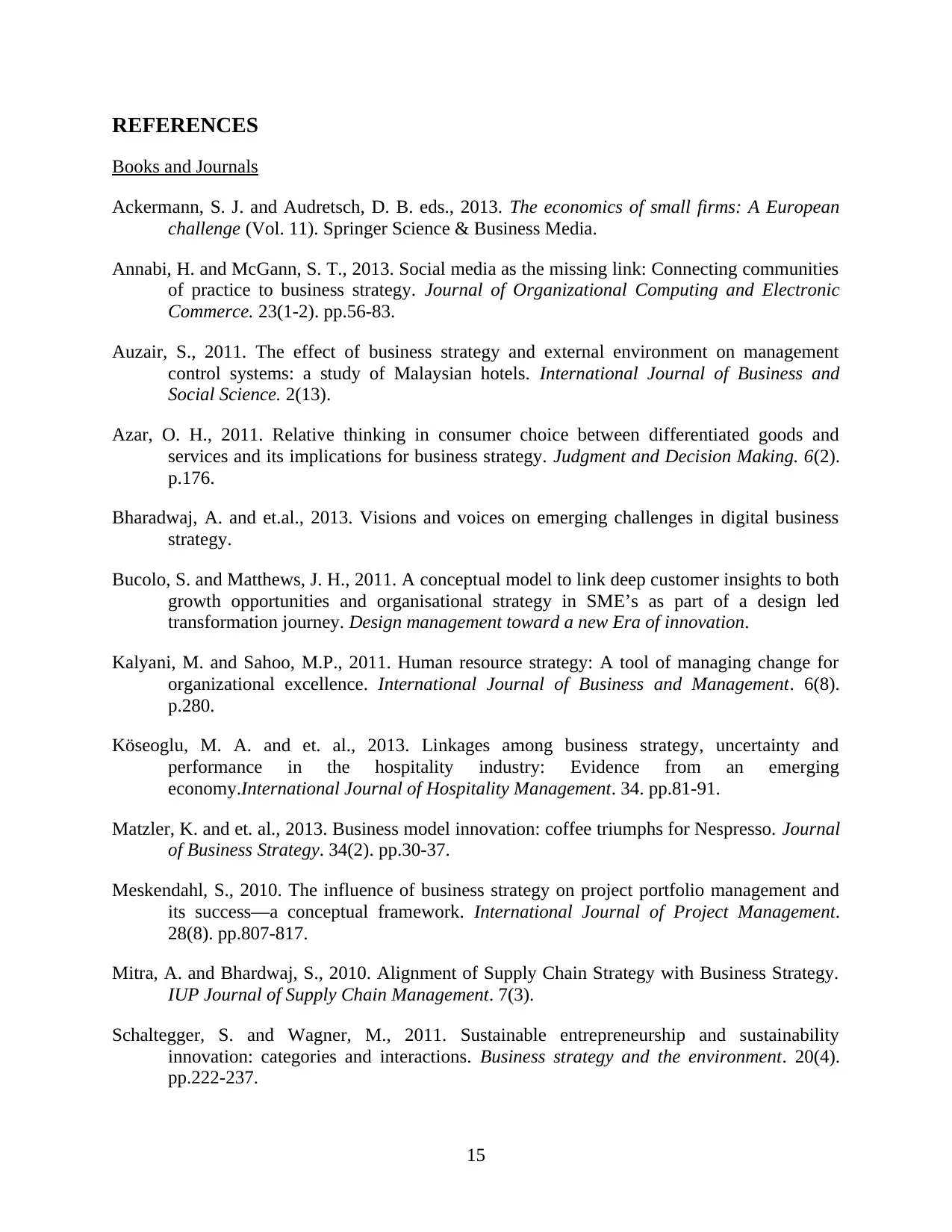
REFERENCES
Books and Journals
Ackermann, S. J. and Audretsch, D. B. eds., 2013. The economics of small firms: A European
challenge (Vol. 11). Springer Science & Business Media.
Annabi, H. and McGann, S. T., 2013. Social media as the missing link: Connecting communities
of practice to business strategy. Journal of Organizational Computing and Electronic
Commerce. 23(1-2). pp.56-83.
Auzair, S., 2011. The effect of business strategy and external environment on management
control systems: a study of Malaysian hotels. International Journal of Business and
Social Science. 2(13).
Azar, O. H., 2011. Relative thinking in consumer choice between differentiated goods and
services and its implications for business strategy. Judgment and Decision Making. 6(2).
p.176.
Bharadwaj, A. and et.al., 2013. Visions and voices on emerging challenges in digital business
strategy.
Bucolo, S. and Matthews, J. H., 2011. A conceptual model to link deep customer insights to both
growth opportunities and organisational strategy in SME’s as part of a design led
transformation journey. Design management toward a new Era of innovation.
Kalyani, M. and Sahoo, M.P., 2011. Human resource strategy: A tool of managing change for
organizational excellence. International Journal of Business and Management. 6(8).
p.280.
Köseoglu, M. A. and et. al., 2013. Linkages among business strategy, uncertainty and
performance in the hospitality industry: Evidence from an emerging
economy.International Journal of Hospitality Management. 34. pp.81-91.
Matzler, K. and et. al., 2013. Business model innovation: coffee triumphs for Nespresso. Journal
of Business Strategy. 34(2). pp.30-37.
Meskendahl, S., 2010. The influence of business strategy on project portfolio management and
its success—a conceptual framework. International Journal of Project Management.
28(8). pp.807-817.
Mitra, A. and Bhardwaj, S., 2010. Alignment of Supply Chain Strategy with Business Strategy.
IUP Journal of Supply Chain Management. 7(3).
Schaltegger, S. and Wagner, M., 2011. Sustainable entrepreneurship and sustainability
innovation: categories and interactions. Business strategy and the environment. 20(4).
pp.222-237.
15
Books and Journals
Ackermann, S. J. and Audretsch, D. B. eds., 2013. The economics of small firms: A European
challenge (Vol. 11). Springer Science & Business Media.
Annabi, H. and McGann, S. T., 2013. Social media as the missing link: Connecting communities
of practice to business strategy. Journal of Organizational Computing and Electronic
Commerce. 23(1-2). pp.56-83.
Auzair, S., 2011. The effect of business strategy and external environment on management
control systems: a study of Malaysian hotels. International Journal of Business and
Social Science. 2(13).
Azar, O. H., 2011. Relative thinking in consumer choice between differentiated goods and
services and its implications for business strategy. Judgment and Decision Making. 6(2).
p.176.
Bharadwaj, A. and et.al., 2013. Visions and voices on emerging challenges in digital business
strategy.
Bucolo, S. and Matthews, J. H., 2011. A conceptual model to link deep customer insights to both
growth opportunities and organisational strategy in SME’s as part of a design led
transformation journey. Design management toward a new Era of innovation.
Kalyani, M. and Sahoo, M.P., 2011. Human resource strategy: A tool of managing change for
organizational excellence. International Journal of Business and Management. 6(8).
p.280.
Köseoglu, M. A. and et. al., 2013. Linkages among business strategy, uncertainty and
performance in the hospitality industry: Evidence from an emerging
economy.International Journal of Hospitality Management. 34. pp.81-91.
Matzler, K. and et. al., 2013. Business model innovation: coffee triumphs for Nespresso. Journal
of Business Strategy. 34(2). pp.30-37.
Meskendahl, S., 2010. The influence of business strategy on project portfolio management and
its success—a conceptual framework. International Journal of Project Management.
28(8). pp.807-817.
Mitra, A. and Bhardwaj, S., 2010. Alignment of Supply Chain Strategy with Business Strategy.
IUP Journal of Supply Chain Management. 7(3).
Schaltegger, S. and Wagner, M., 2011. Sustainable entrepreneurship and sustainability
innovation: categories and interactions. Business strategy and the environment. 20(4).
pp.222-237.
15
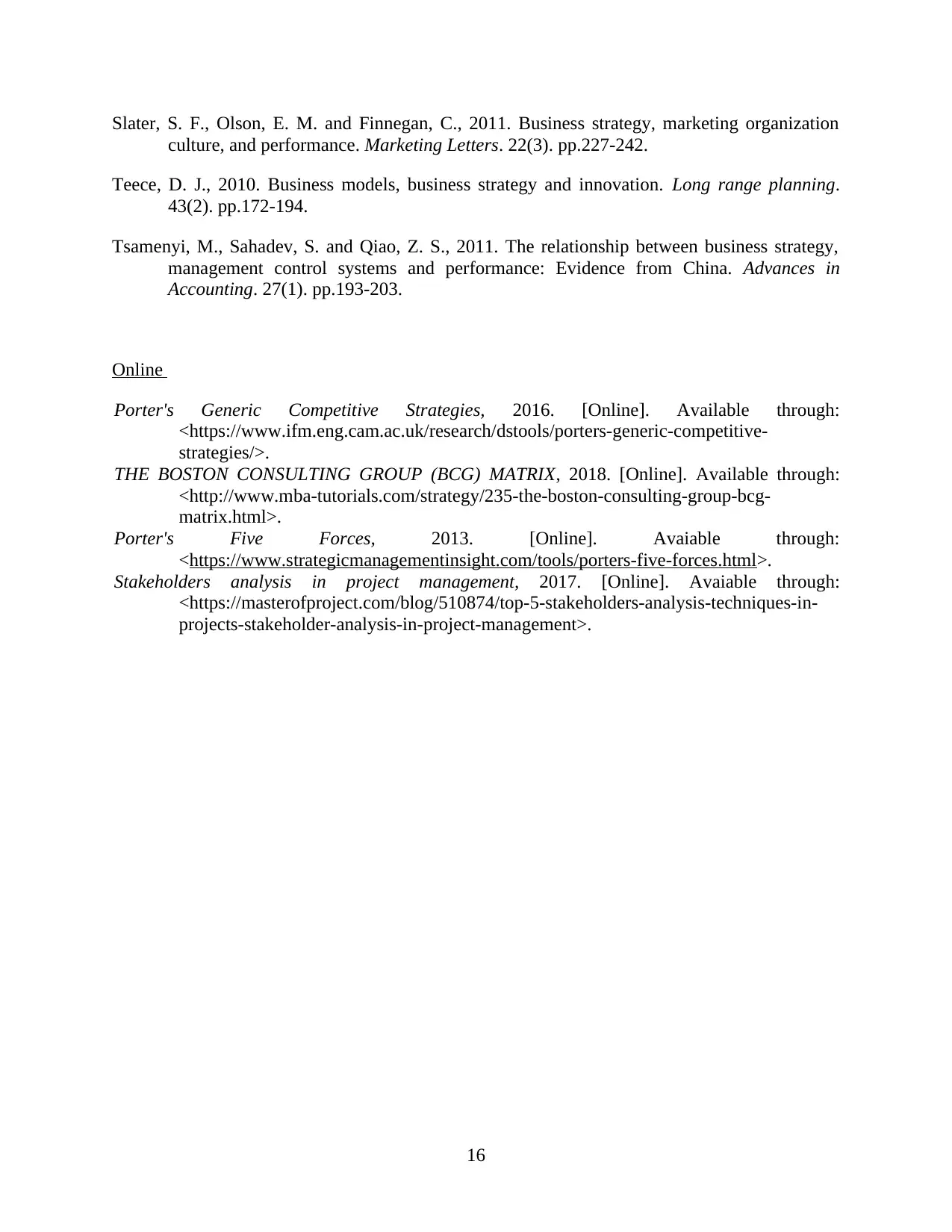
Slater, S. F., Olson, E. M. and Finnegan, C., 2011. Business strategy, marketing organization
culture, and performance. Marketing Letters. 22(3). pp.227-242.
Teece, D. J., 2010. Business models, business strategy and innovation. Long range planning.
43(2). pp.172-194.
Tsamenyi, M., Sahadev, S. and Qiao, Z. S., 2011. The relationship between business strategy,
management control systems and performance: Evidence from China. Advances in
Accounting. 27(1). pp.193-203.
Online
Porter's Generic Competitive Strategies, 2016. [Online]. Available through:
<https://www.ifm.eng.cam.ac.uk/research/dstools/porters-generic-competitive-
strategies/>.
THE BOSTON CONSULTING GROUP (BCG) MATRIX, 2018. [Online]. Available through:
<http://www.mba-tutorials.com/strategy/235-the-boston-consulting-group-bcg-
matrix.html>.
Porter's Five Forces, 2013. [Online]. Avaiable through:
<https://www.strategicmanagementinsight.com/tools/porters-five-forces.html>.
Stakeholders analysis in project management, 2017. [Online]. Avaiable through:
<https://masterofproject.com/blog/510874/top-5-stakeholders-analysis-techniques-in-
projects-stakeholder-analysis-in-project-management>.
16
culture, and performance. Marketing Letters. 22(3). pp.227-242.
Teece, D. J., 2010. Business models, business strategy and innovation. Long range planning.
43(2). pp.172-194.
Tsamenyi, M., Sahadev, S. and Qiao, Z. S., 2011. The relationship between business strategy,
management control systems and performance: Evidence from China. Advances in
Accounting. 27(1). pp.193-203.
Online
Porter's Generic Competitive Strategies, 2016. [Online]. Available through:
<https://www.ifm.eng.cam.ac.uk/research/dstools/porters-generic-competitive-
strategies/>.
THE BOSTON CONSULTING GROUP (BCG) MATRIX, 2018. [Online]. Available through:
<http://www.mba-tutorials.com/strategy/235-the-boston-consulting-group-bcg-
matrix.html>.
Porter's Five Forces, 2013. [Online]. Avaiable through:
<https://www.strategicmanagementinsight.com/tools/porters-five-forces.html>.
Stakeholders analysis in project management, 2017. [Online]. Avaiable through:
<https://masterofproject.com/blog/510874/top-5-stakeholders-analysis-techniques-in-
projects-stakeholder-analysis-in-project-management>.
16
1 out of 18
Related Documents
Your All-in-One AI-Powered Toolkit for Academic Success.
+13062052269
info@desklib.com
Available 24*7 on WhatsApp / Email
![[object Object]](/_next/static/media/star-bottom.7253800d.svg)
Unlock your academic potential
© 2024 | Zucol Services PVT LTD | All rights reserved.





